D Link CS6010LA1 HD Wirless N 360 degree Home Network Camera User Manual DCS 6010L A1 Manual v1 00 WW
D Link Corporation HD Wirless N 360 degree Home Network Camera DCS 6010L A1 Manual v1 00 WW
D Link >
Contents
- 1. User Manual 01
- 2. User Manual 02
User Manual 02
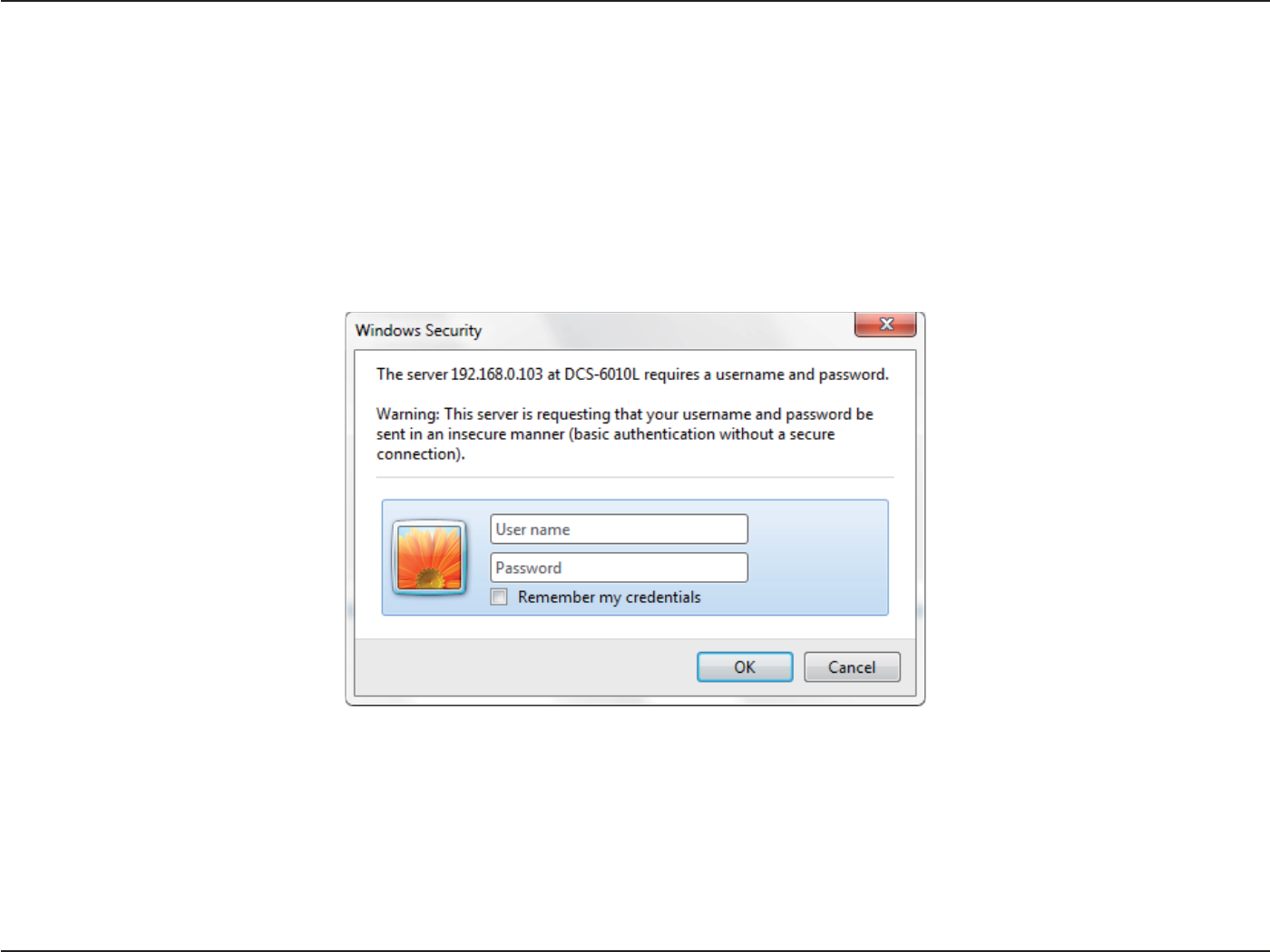
35D-Link DCS-6010L User Manual
Section 4: Conguration
Conguration
Using the Conguration Interface
After completing the Camera Installation Wizard, you are ready to use your camera. The camera’s built-in Web conguration utility is designed to
allow you to easily access and congure your DCS-6010L. At the end of the wizard, click Go To Camera, or enter the IP address of your camera into
a web browser, such as Mozilla Firefox. To log in, use the User name admin and the password you created in the Installation Wizard. If you did not
create a password, the default password is blank. After entering your password, click OK.
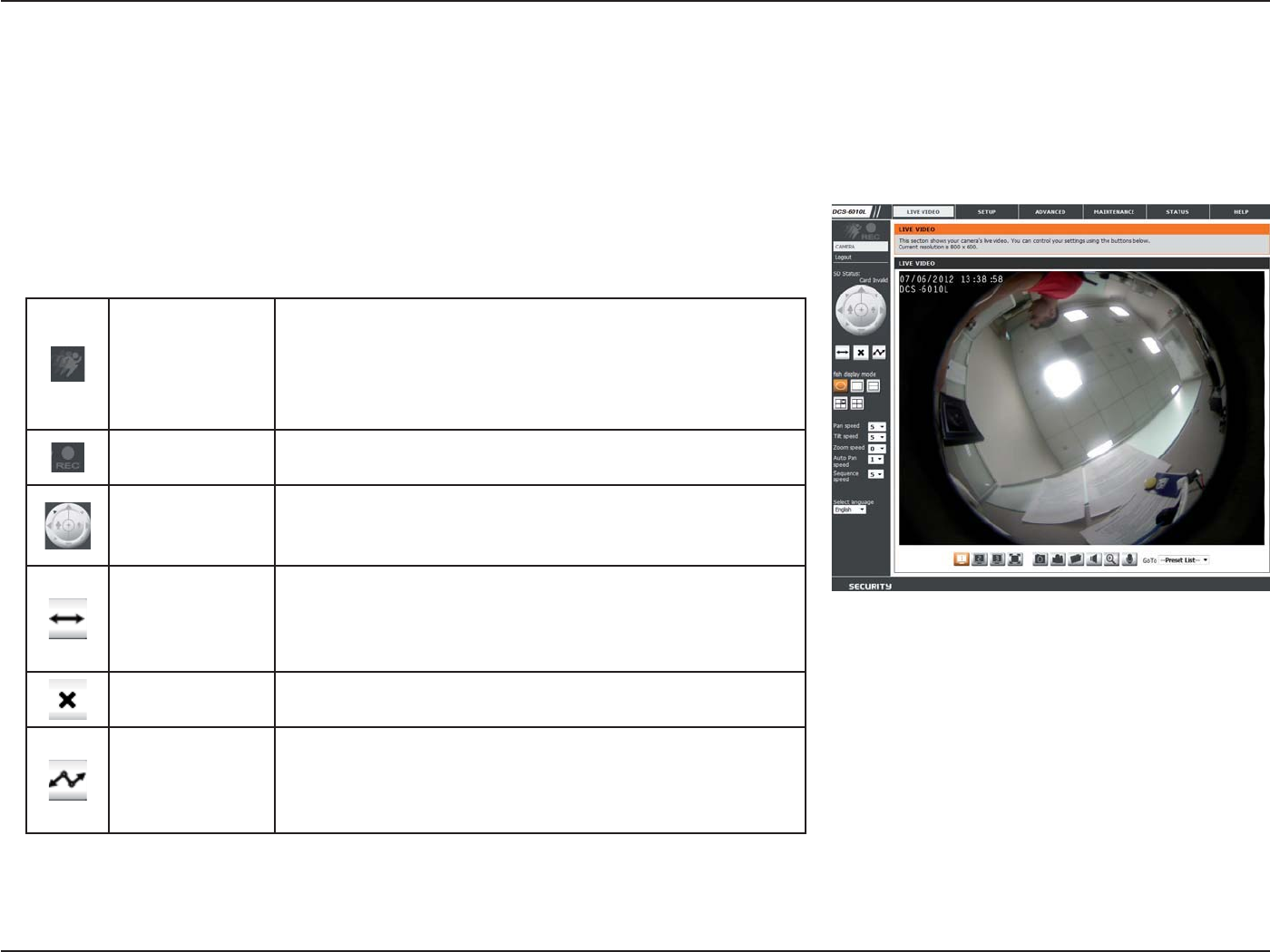
36D-Link DCS-6010L User Manual
Section 4: Conguration
Live Video
This section shows your camera’s live video. You may select any of the available icons listed below to operate the camera. You may also select your
language using the drop-down menu on the left side of the screen.
You can zoom in and out on the live video image using your mouse. Right-click to zoom out or left-click to zoom in on the image.
Motion Trigger
Indicator
This indicator will change color when a trigger event
occurs.
Note: The video motion feature for your camera must be
enabled.
Recording
Indicator
When a recording is in progress, this indicator will change
color.
Control Pad
This control pad can be used to electronically pan, tilt, and
zoom (ePTZ) within the camera's predened view area, if
one has been dened.
Auto Pan
Click this button to start the automated circular rotation
through a regional view (360* continuous rotation).
Note: This function does not apply in a Panoramic view
because a panoramic view already shows the full coverage.
Stop Click this button to stop the Auto Pano and Auto Rotate
functions.
Preset Path
Once you have determined a list of preset PTZ positions, click
this button to consecutively display views of these positions.
The DCS-6010L will display these views continuously. For
more information please refer to "Preset" on page 53
This option displays the status of the SD card. If no SD card has been
inserted, this screen will display the message "Card Invalid."
SD Status:
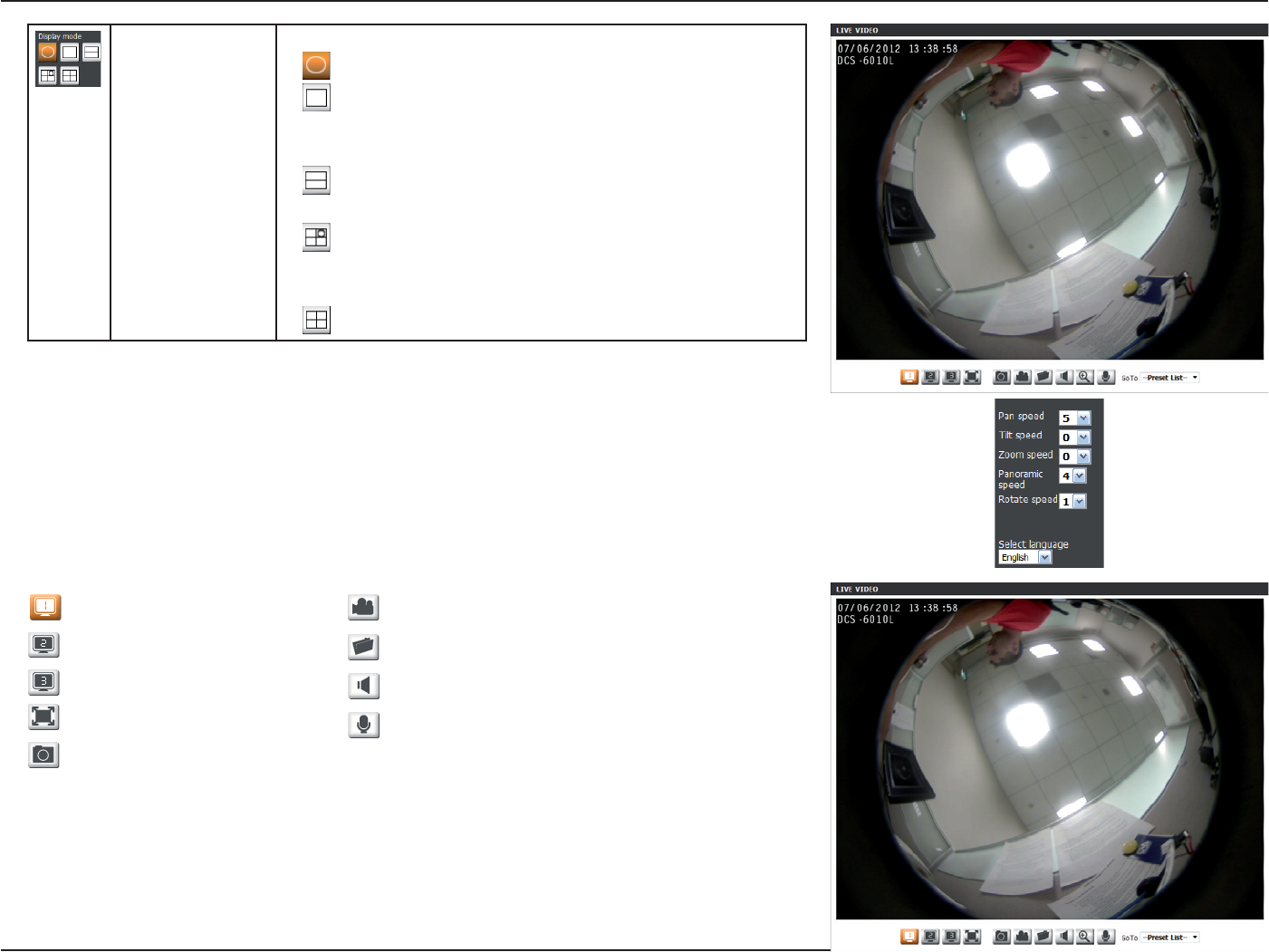
37D-Link DCS-6010L User Manual
Section 4: Conguration
You can set the speed of pan/tilt/zoom/panoramic/rotate movement
by using the dropdown menus.
You may select the interface language using this menu.
Pan/Tilt/Zoom/
Panoramic/
Rotate Speed:
Language:
Display Mode Here, you can select between the dierent display modes:
Fisheye Mode: shows the full camera view
Normal Mode: shows a corrected view similar to a
standard camera view that you can move using the
control pad.
Panoramic Mode: This shows a corrected, full 180
view across 2 video panels.
Multi-View with Fisheye: This shows a multiple
window view, with a full Fisheye view in the top-
right panel.
Multi-View: This shows a multiple window view.
If any presets have been dened, selecting a preset from this list will
display it.
Go To:
(Preset List)
Video Prole 1
Video Prole 2
Video Prole 3
Full screen mode
Take a Snapshot
Record a Video Clip
Set a Storage Folder
Listen/Stop Audio In (from microphone)
Start/Stop Audio Out (to speaker)

38D-Link DCS-6010L User Manual
Section 4: Conguration
Setup
Setup Wizard
To congure your Network Camera, click Internet Connection Setup Wizard. Alternatively,
you may click Manual Internet Connection Setup to manually congure your Network
Camera and skip to "Network Setup" on page 44.
To quickly congure your Network Camera’s motion detection settings, click Motion
Detection Setup Wizard. If you want to enter your settings without running the wizard, click
Manual Motion Detection Setup and skip to"Motion Detection" on page 55.
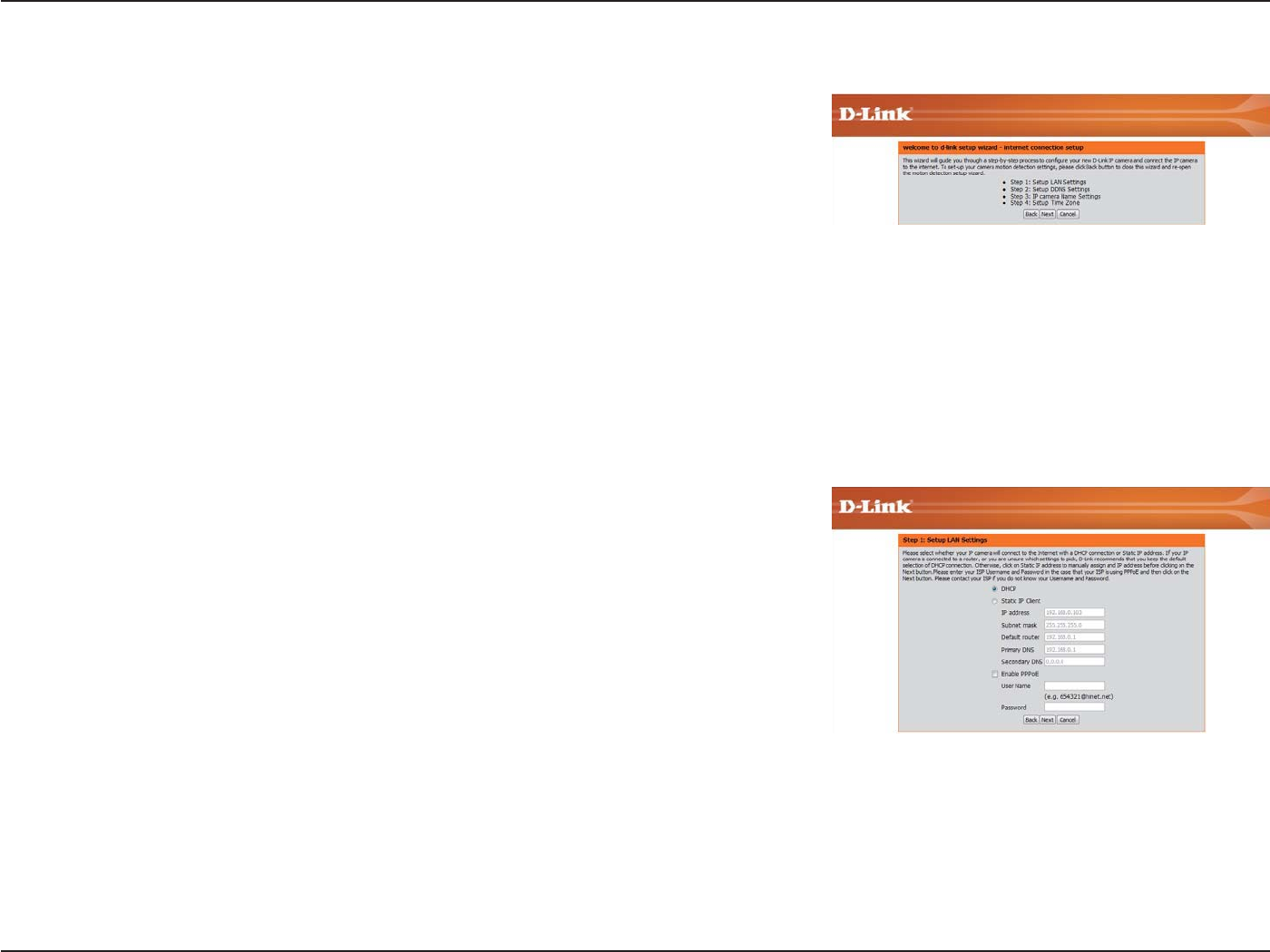
39D-Link DCS-6010L User Manual
Section 4: Conguration
Internet Connection Setup Wizard
This wizard will guide you through a step-by-step process to congure your new D-Link
Camera and connect the camera to the internet. Click Next to continue.
Note: Select DHCP if you are unsure of which settings to choose.
Click Next to continue.
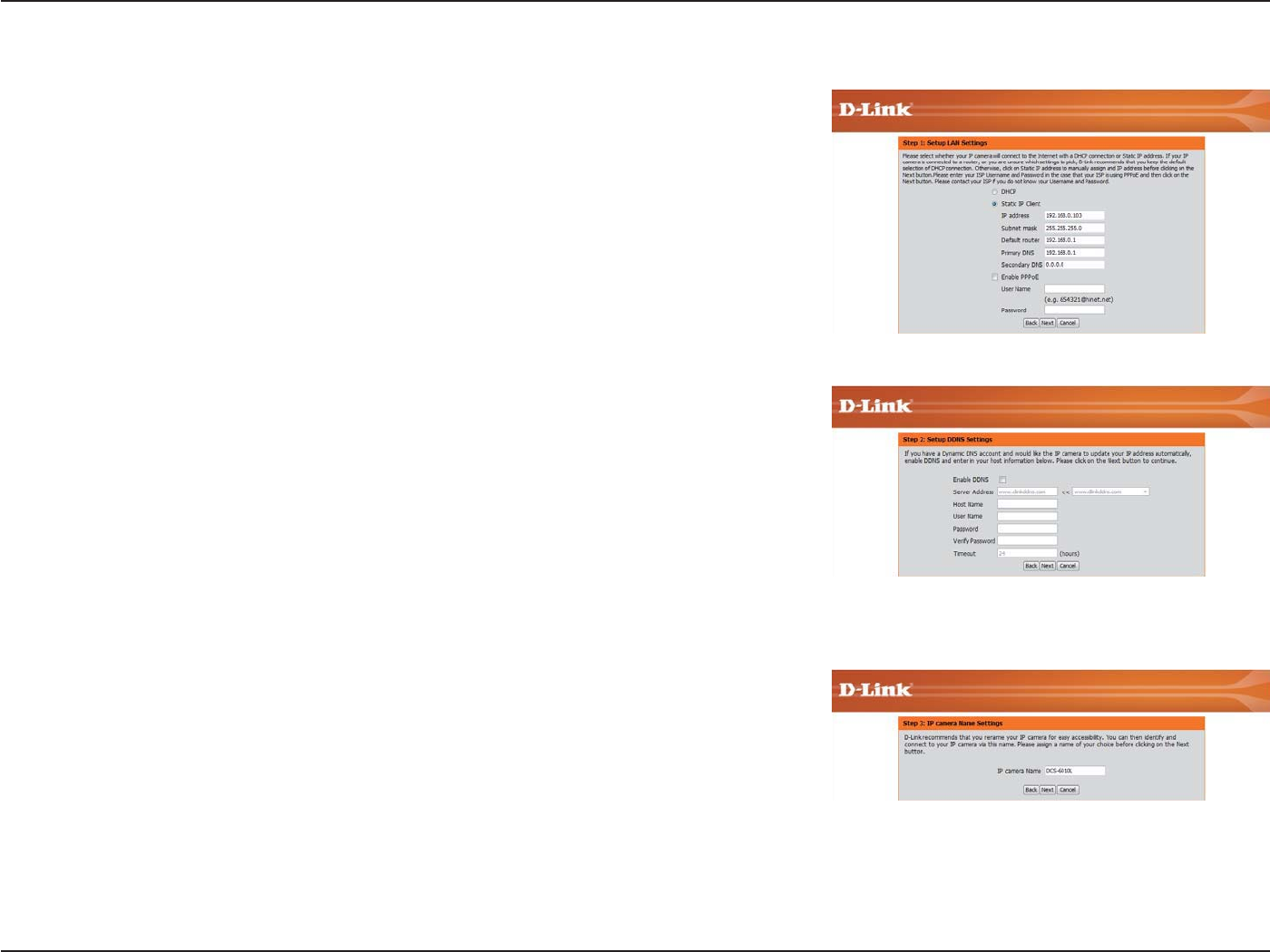
40D-Link DCS-6010L User Manual
Section 4: Conguration
Select Static IP if your Internet Service Provider has provided you with connection settings, or
if you wish to set a static address within your home network. Enter the correct conguration
information and click Next to continue.
If you are using PPPoE, select Enable PPPoE and enter your user name and password,
otherwise click Next to continue.
If you have a Dynamic DNS account and would like the camera to update your IP address
automatically, Select Enable DDNS and enter your host information. Click Next to continue.
Enter a name for your camera and click Next to continue.
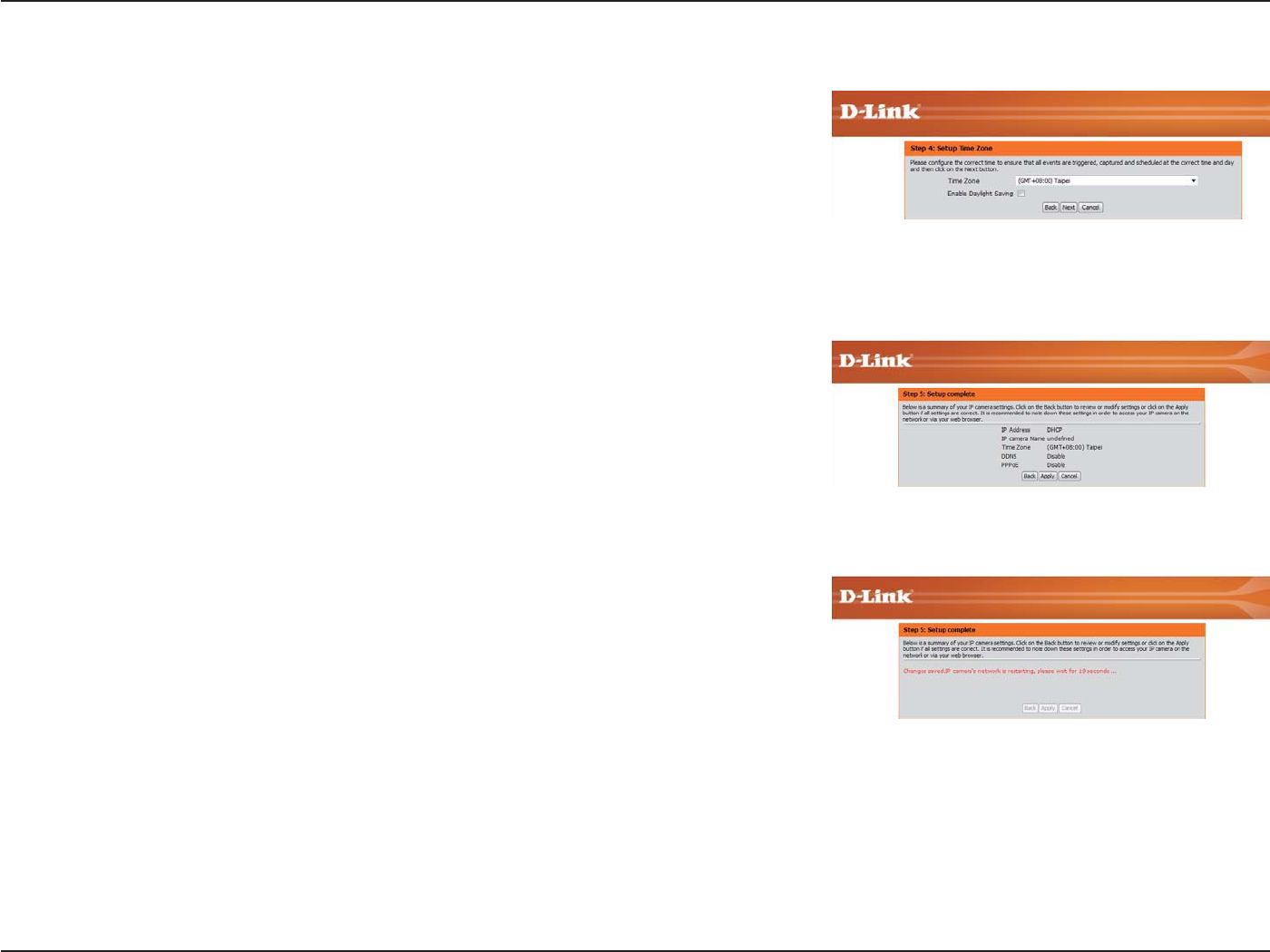
41D-Link DCS-6010L User Manual
Section 4: Conguration
Congure the correct time to ensure that all events will be triggered as scheduled. Click Next
to continue.
Conrm the settings are correct and click Apply to save them..
The settings will be saved to the DCS-6010L and the camera will restart.
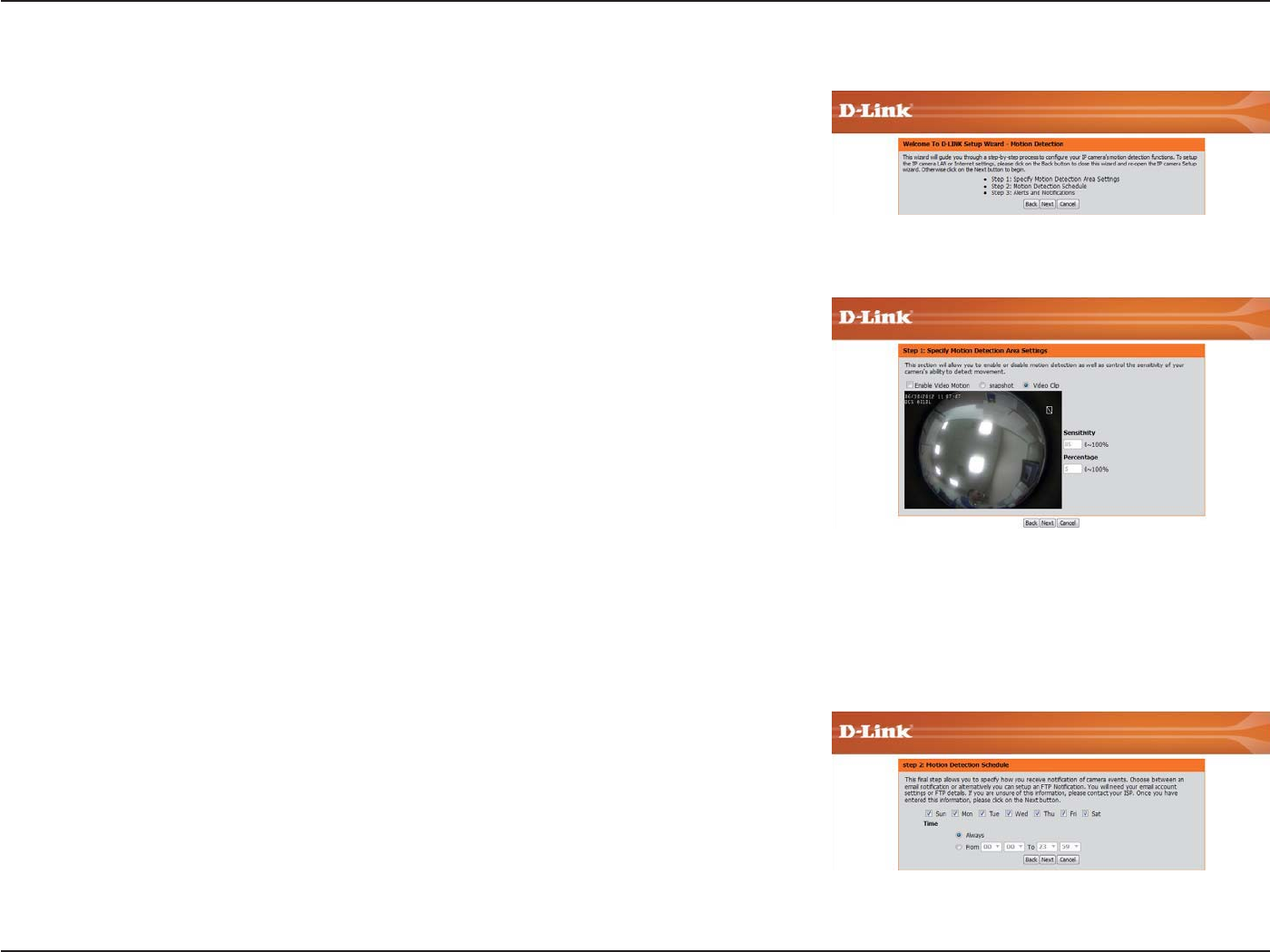
42D-Link DCS-6010L User Manual
Section 4: Conguration
This wizard will guide you through a step-by-step process to congure your camera's
motion detection functions.
Click Next to continue.
Motion Detection Setup Wizard
Step 1
This step will allow you to enable or disable motion detection, specify the detection sensitivity,
and adjust the camera’s ability to detect movement.
You may specify whether the camera should capture a snapshot or a video clip when motion
is detected.
Please see the Motion Detection section on "Motion Detection" on page 55for information
about how to congure motion detection.
Step 2
This step allows you to enable motion detection based on a customized schedule. Specify the
day and hours. You may also choose to always record whenever motion is detected.
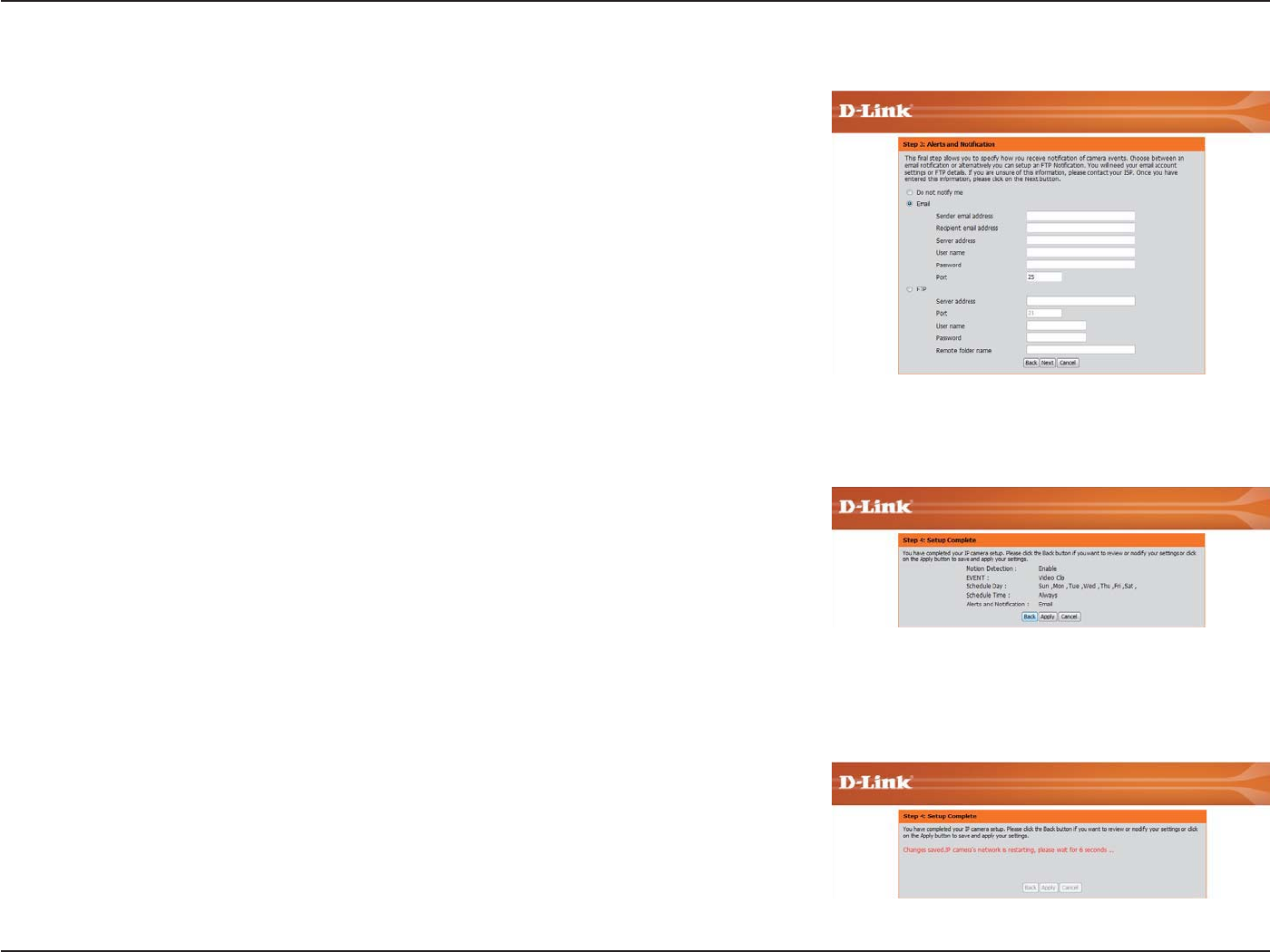
43D-Link DCS-6010L User Manual
Section 4: Conguration
Step 3
This step allows you to specify how you will receive event notications from your camera. You
may choose not to receive notications, or to receive notications via e-mail or FTP.
Please enter the relevant information for your e-mail or FTP account.
Click Next to continue.
Step 4
You have completed the Motion Detection Wizard.
Please verify your settings and click Apply to save them.
Please wait a few moments while the camera saves your settings and restarts.
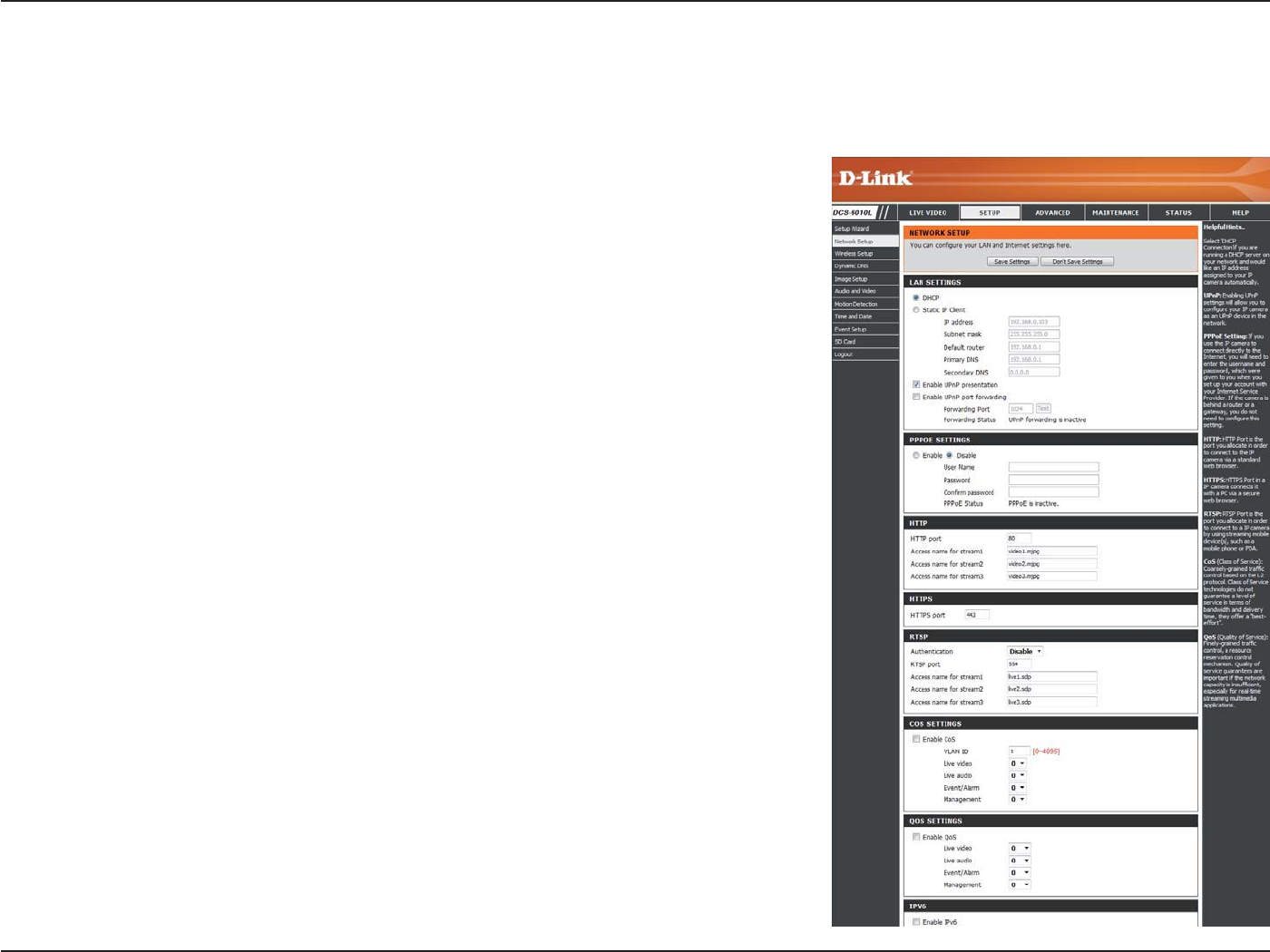
44D-Link DCS-6010L User Manual
Section 4: Conguration
Network Setup
Use this section to congure the network connections for your camera. All relevant information must be entered accurately. After making any
changes, click the Save Settings button to save your changes.
LAN Settings:
DHCP:
Static IP Client:
IP Address:
Subnet Mask:
Default Gateway:
Primary DNS:
Secondary DNS:
This section lets you congure settings for your local
area network.
Select this connection if you have a DHCP server running
on your network and would like your camera to obtain
an IP address automatically.
If you choose DHCP, you do not need to ll out the IP
address settings.
You may obtain a static or xed IP address and other
network information from your network administrator
for your camera. A static IP address may simplify access
to your camera in the future.
Enter the xed IP address in this eld.
This number is used to determine if the destination is in
the same subnet. The default value is 255.255.255.0.
The gateway used to forward frames to destinations in a
dierent subnet. Invalid gateway settings may cause the
failure of transmissions to a dierent subnet.
The primary domain name server translates names to IP
addresses.
The secondary DNS acts as a backup to the primary DNS.
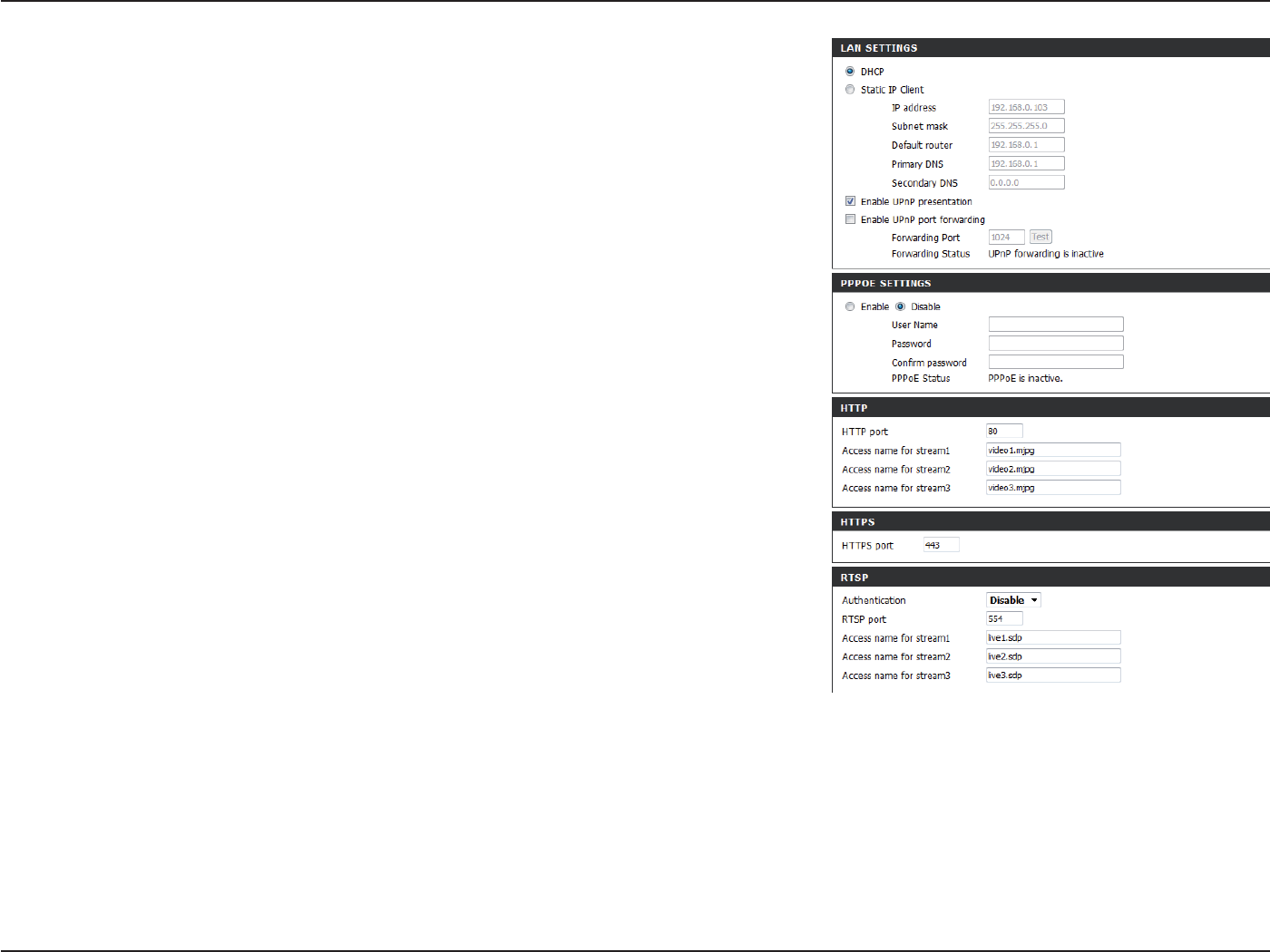
45D-Link DCS-6010L User Manual
Section 4: Conguration
Enable UPnP Presentation:
Enable UPnP Port Forwarding:
Enable PPPoE:
User Name / Password:
HTTP Port:
Access Name for Stream 1~3:
HTTPS Port:
RTSP Port:
Enabling this setting allows your camera to be congured
as a UPnP device on your network.
Enabling this setting allows the camera to add port
forwarding entries into the router automatically on a
UPnP capable network.
Enable this setting if your network uses PPPoE.
Enter the username and password for your PPPoE
account. Re-enter your password in the Conrm
Password eld. You may obtain this information from
your ISP.
The default port number is 80.
The default name is video#.mjpg, where # is the number
of the stream.
You may use a PC with a secure browser to connect to
the HTTPS port of the camera. The default port number
is 443.
The port number that you use for RTSP streaming to
mobile devices, such as mobile phones or PDAs. The
default port number is 554. You may specify the address
of a particular stream. For instance, live1.sdp can be
accessed at rtsp://x.x.x.x/video1.sdp where the x.x.x.x
represents the ip address of your camera.
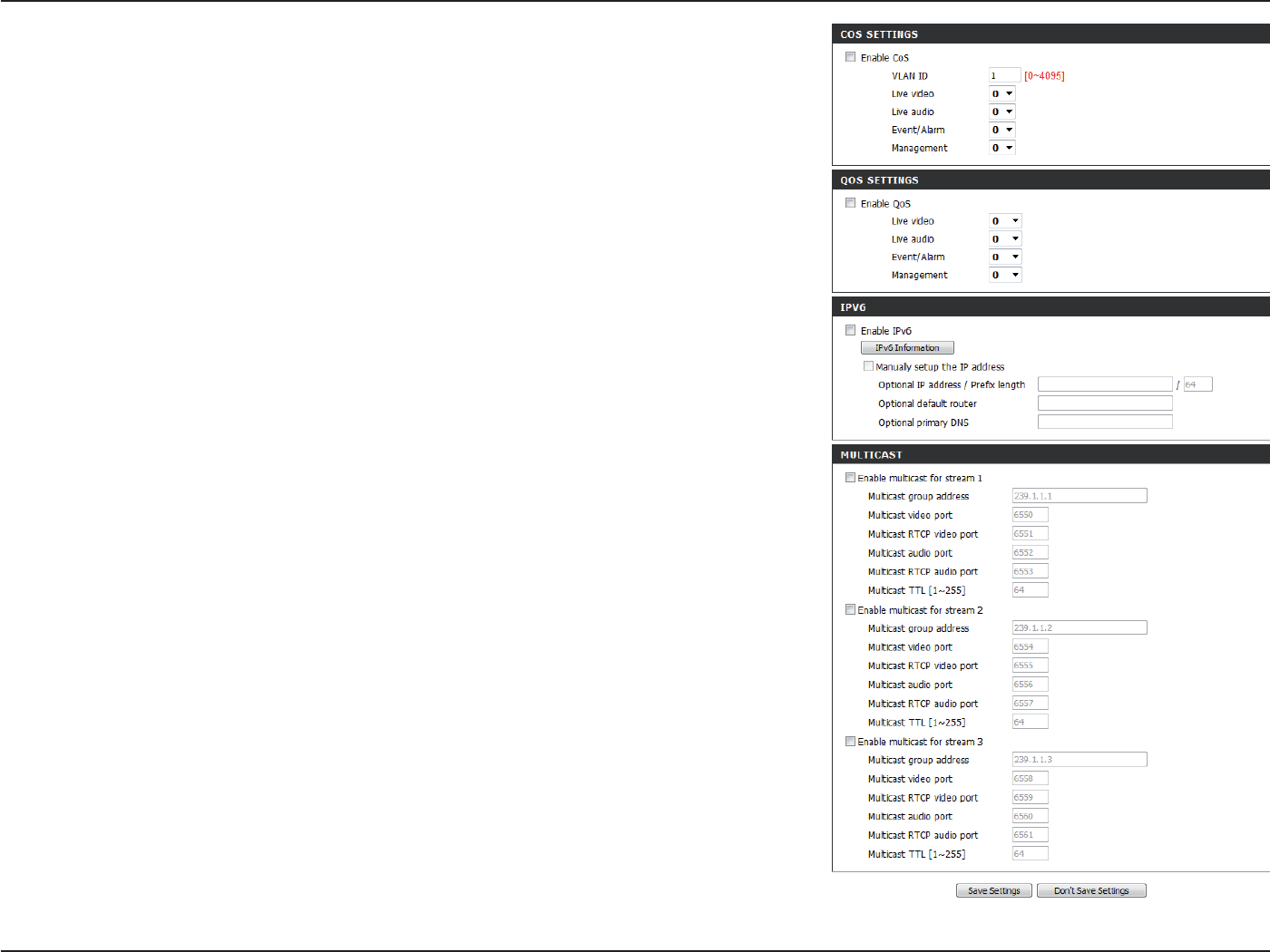
46D-Link DCS-6010L User Manual
Section 4: Conguration
Enable CoS:
Enable QoS:
Enable IPV6:
Enable Multicast for stream
Enabling the Class of Service setting implements a
best-eort policy without making any bandwidth
reservations.
Enabling QoS allows you to specify a trac priority
policy to ensure a consistent Quality of Service during
busy periods. If the Network Camera is connected to a
router that itself implements QoS, the router's settings
will override the QoS settings of the camera.
Enable the IPV6 setting to use the IPV6 protocol. Enabling
the option allows you to manually set up the address,
specify an optional IP address, specify an optional router
and an optional primary DNS.
The DCS-6010L allows you to multicast each of the
available streams via group address and specify the TTL
value for each stream. Enter the port and TTL settings
you wish to use if you do not want to use the defaults.
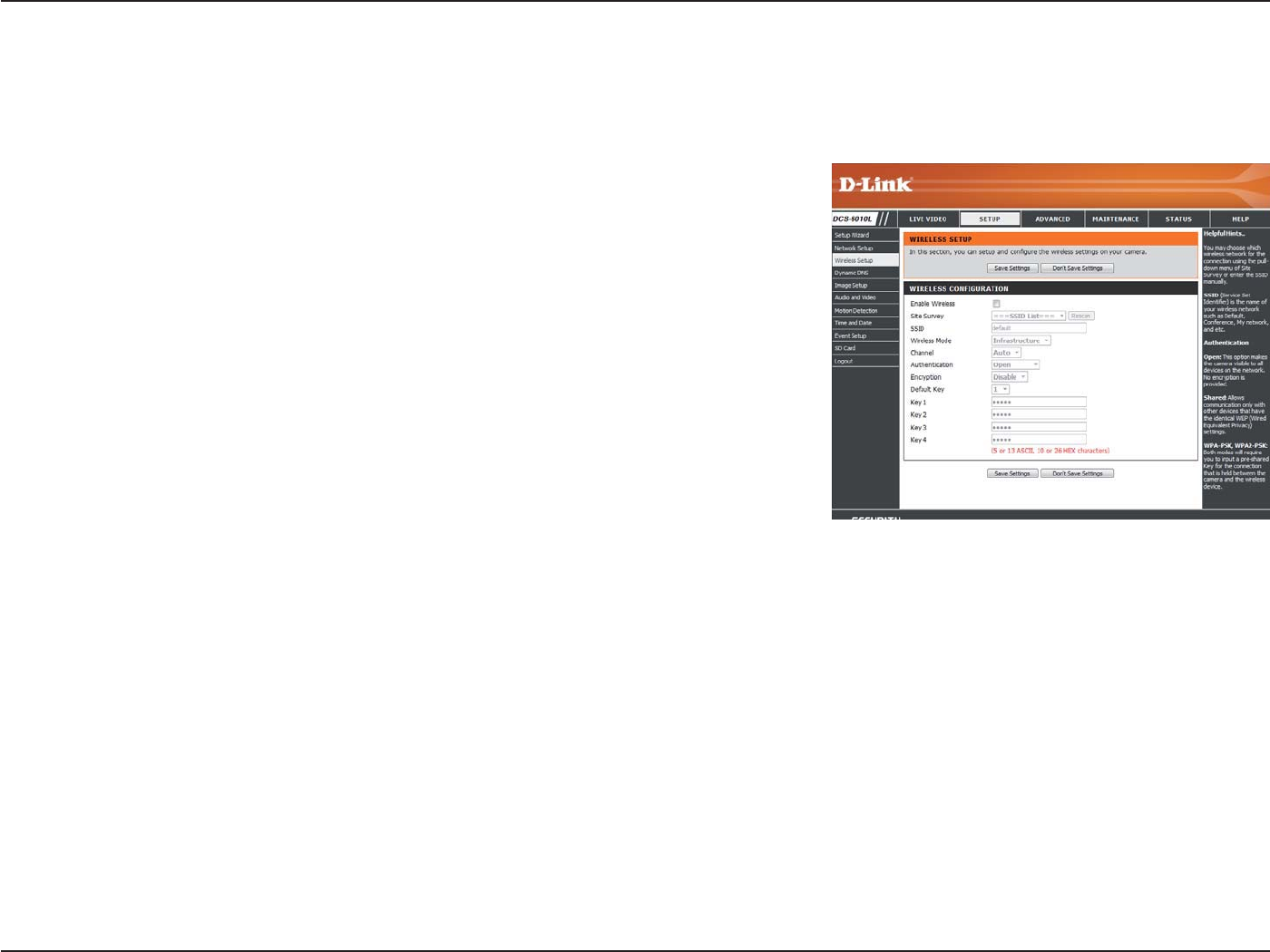
47D-Link DCS-6010L User Manual
Section 4: Conguration
Wireless Setup
This section allows you to set up and congure the wireless settings on your camera. After making any changes, click the Save Settings button to
save your changes.
Site Survey:
SSID:
Wireless Mode:
Channel:
Authentication:
Encryption:
Key:
Click the Rescan button to scan for available wireless
networks. After scanning, you can use the drop-down
box to select an available wireless network. The related
information (SSID, Wireless Mode, Channel, Authentication,
Encryption) will be automatically lled in for you.
Enter the SSID of the wireless access point you wish to
use.
Use the drop-down box to select the mode of the
wireless network you wish to connect to. Infrastructure
is normally used to connect to an access point or router.
Ad-Hoc is usually used to connect directly to another
computer.
If you are using Ad Hoc mode, select the channel of the
wireless network you wish to connect to, or select Auto.
Select the authentication you use on your wireless
network - Open, Shared, WPA-PSK, or WPA2-PSK.
If you use WPA-PSK or WPA2-PSK authentication, you
will need to specify whether your wireless network
uses TKIP or AES encryption. If you use Open or Shared
authentication, WEP encryption should be the setting.
If you use WEP, WPA-PSK, or WPA2-PSK authentication,
enter the Key (also known as password) used for your
wireless network.
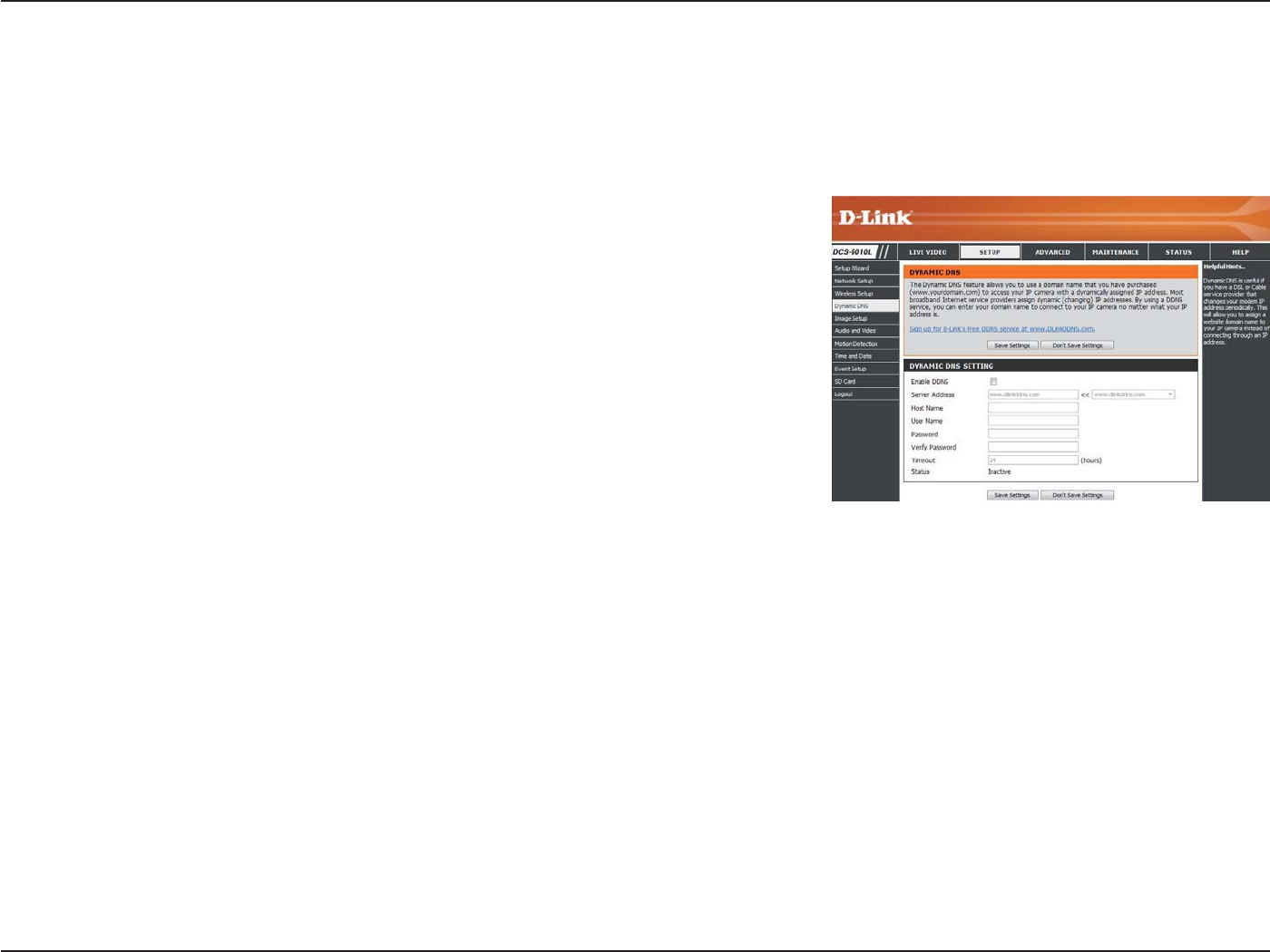
48D-Link DCS-6010L User Manual
Section 4: Conguration
Dynamic DNS
DDNS (Dynamic Domain Name Server) will hold a DNS host name and synchronize the public IP address of the modem when it has been modied.
A user name and password are required when using the DDNS service. After making any changes, click the Save Settings button to save your
changes.
Enable DDNS:
Server Address:
Host Name:
User Name:
Password:
Timeout:
Status:
Select this checkbox to enable the DDNS function.
Select your Dynamic DNS provider from the pull down
menu or enter the server address manually.
Enter the host name of the DDNS server.
Enter the user name or e-mail used to connect to your
DDNS account.
Enter the password used to connect to your DDNS
server account.
Enter the DNS timeout values you wish to use.
Indicates the connection status, which is automatically
determined by the system.
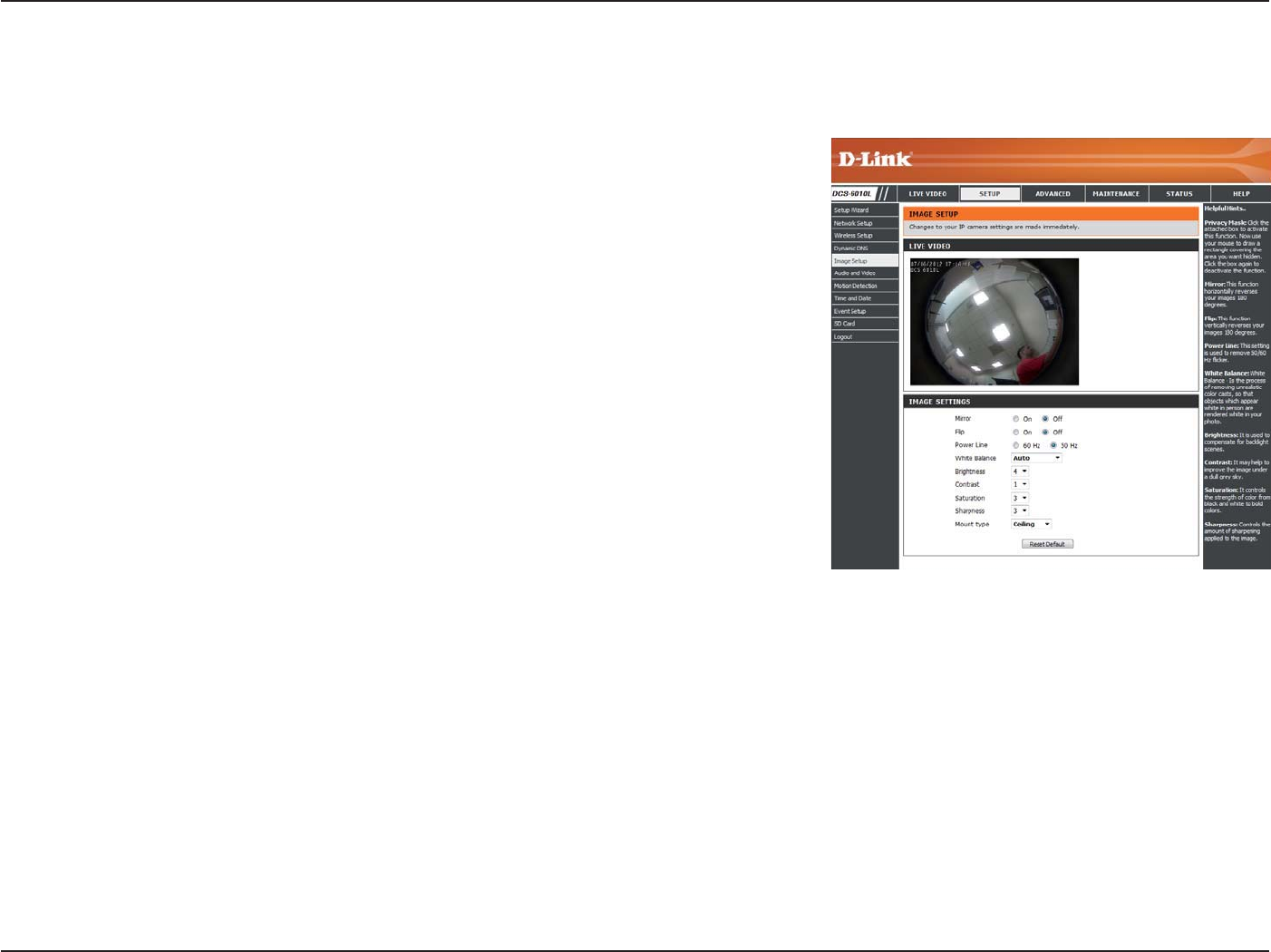
49D-Link DCS-6010L User Manual
Section 4: Conguration
Image Setup
In this section, you may congure the video image settings for your camera. A preview of the image will be shown in Live Video.
Mirror:
Flip:
Power Line:
White Balance:
Exposure Mode:
Denoise:
Brightness:
This will mirror the image horizontally.
This will ip the image vertically. When turning Flip on,
you may want to consider turning Mirror on as well.
Select the frequency used by your power lines to avoid
interference or distortion.
Use the drop-down box to change white balance settings
to help balance colors for dierent environments. You
can choose from Auto, Outdoor, Indoor, Fluorescent,
and Push Hold.
Changes the exposure mode. Use the drop-down
box to set the camera for Indoor, Outdoor, or Night
environments, or to Moving to capture moving objects.
The Low Noise option will focus on creating a high-
quality picture without noise. You can also create 3
dierent custom exposure modes. The Max Gain setting
will allow you to control the maximum amount of gain
to apply to brighten the picture.
This setting controls the amount of noise reduction that
will be applied to the picture.
Adjust this setting to compensate for backlit subjects.
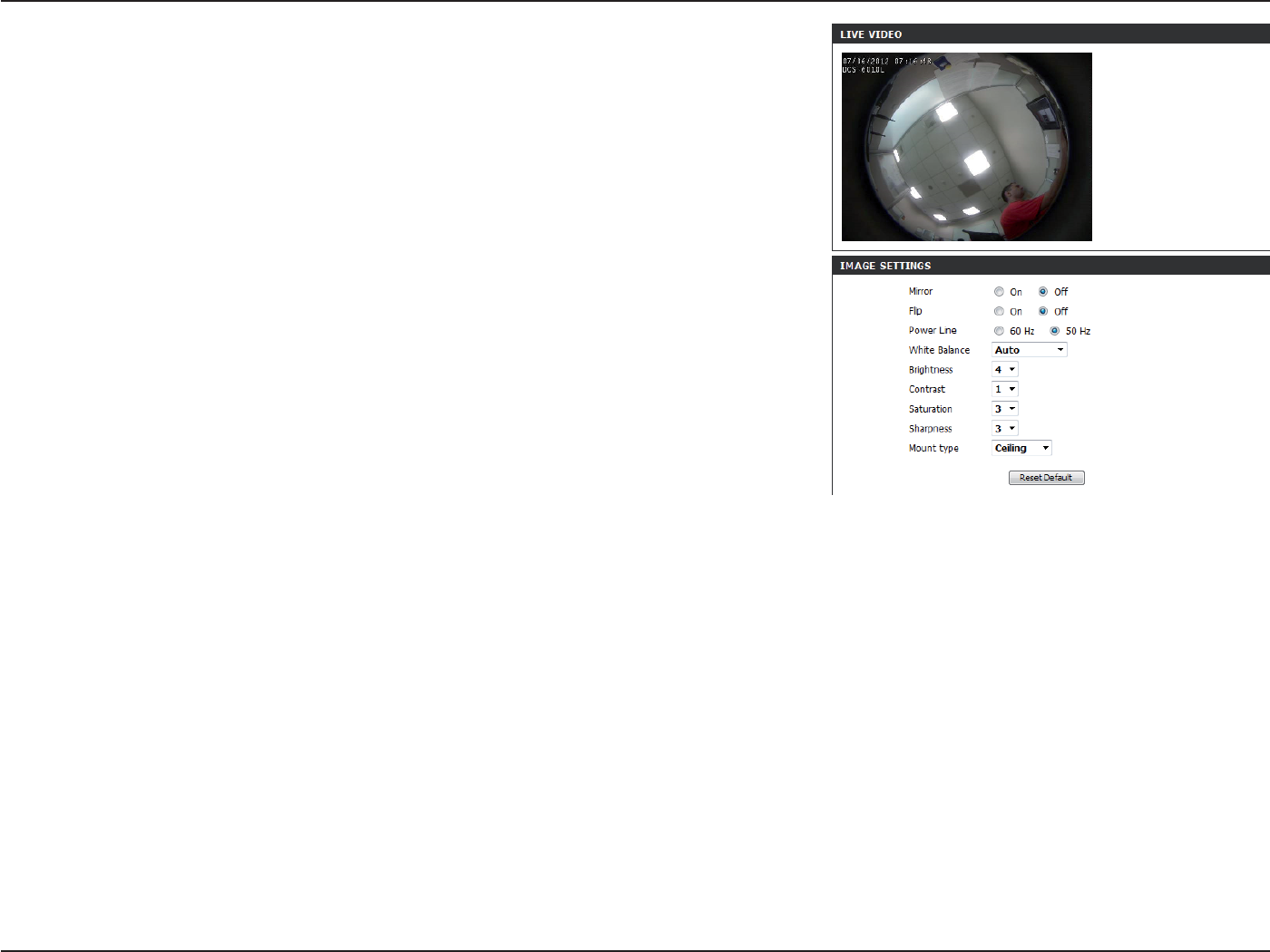
50D-Link DCS-6010L User Manual
Section 4: Conguration
Contrast:
Saturation:
Sharpness:
Reset Default
Mounting:
Adjust this setting to alter the color intensity/strength.
This setting controls the amount of coloration, from
grayscale to fully saturated.
Specify a value from 0 to 8 to specify how much
sharpening to apply to the image.
Click this button to reset the image to factory default
settings.
Select the correct mounting type from either Ceiling, Wall,
or Desktop to ensure the PTZ controls respond accurately.
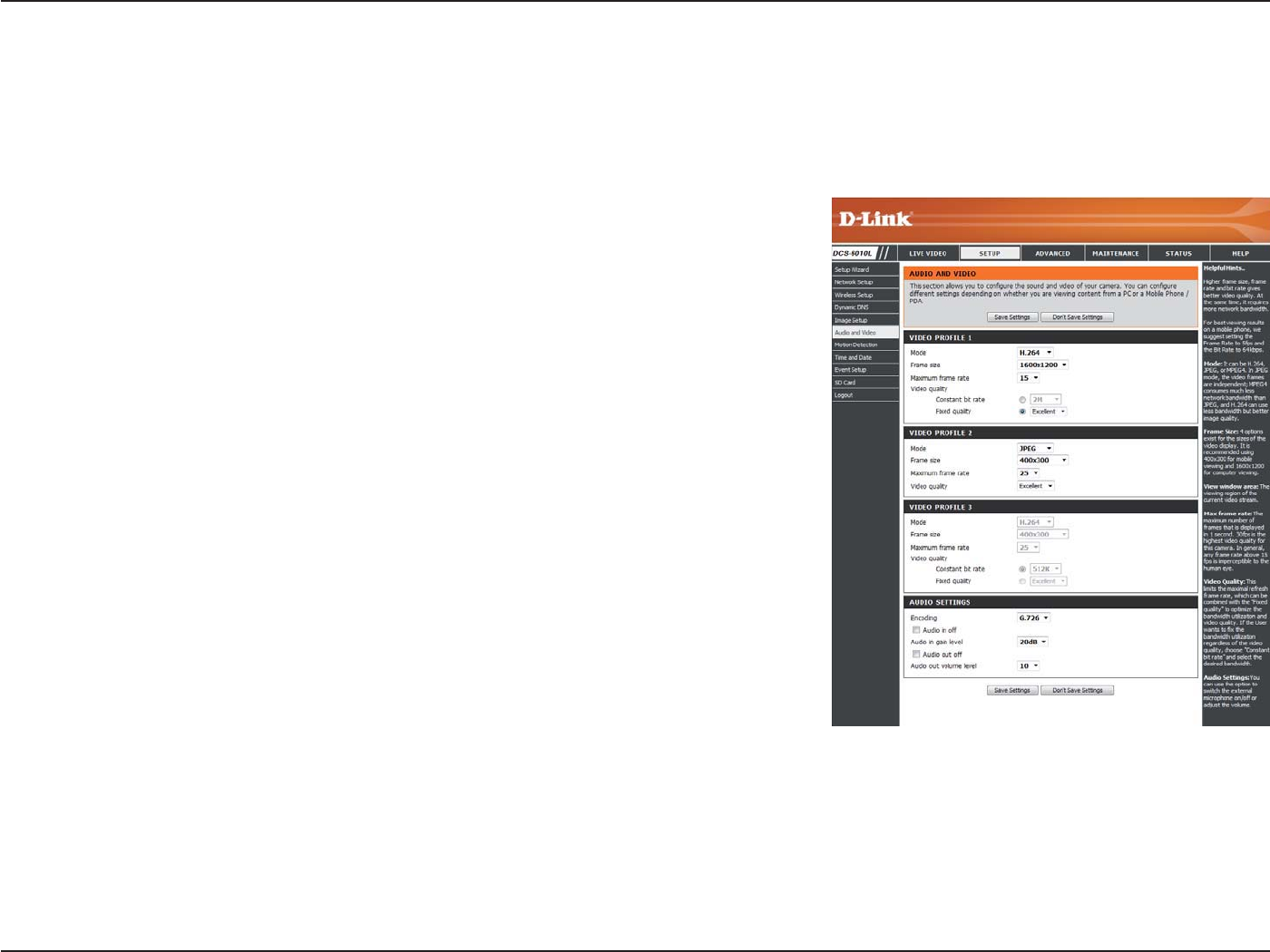
51D-Link DCS-6010L User Manual
Section 4: Conguration
Audio and Video
You may congure up to 3 video proles with dierent settings for your camera. Hence, you may set up dierent proles for your computer and
mobile display. In addition, you may also congure the two-way audio settings for your camera. After making any changes, click the Save Settings
button to save your changes.
Mode:
Frame size / View window area:
Maximum frame rate:
Video Quality:
Constant bit rate:
Fixed quality:
Encoding
Set the video codec to be used to JPEG, MPEG-4, or
H.264.
1600 x 1200, 1200 x 900, 800 x 600, 400 x 300
A higher frame rate provides smoother motion for
videos, and requires more bandwidth. Lower frame
rates will result in stuttering motion, and requires less
bandwidth.
This limits the maximum frame rate, which can be
combined with the "Fixed quality" option to optimize
the bandwidth utilization and video quality. If xed
bandwidth utilization is desired regardless of the video
quality, choose "Constant bit rate" and select the desired
bandwidth.
The bps will aect the bit rate of the video recorded
by the camera. Higher bit rates result in higher video
quality.
Select the image quality level for the camera to try to
maintain. High quality levels will result in increased bit
rates.
Choose between G.726 or G.711
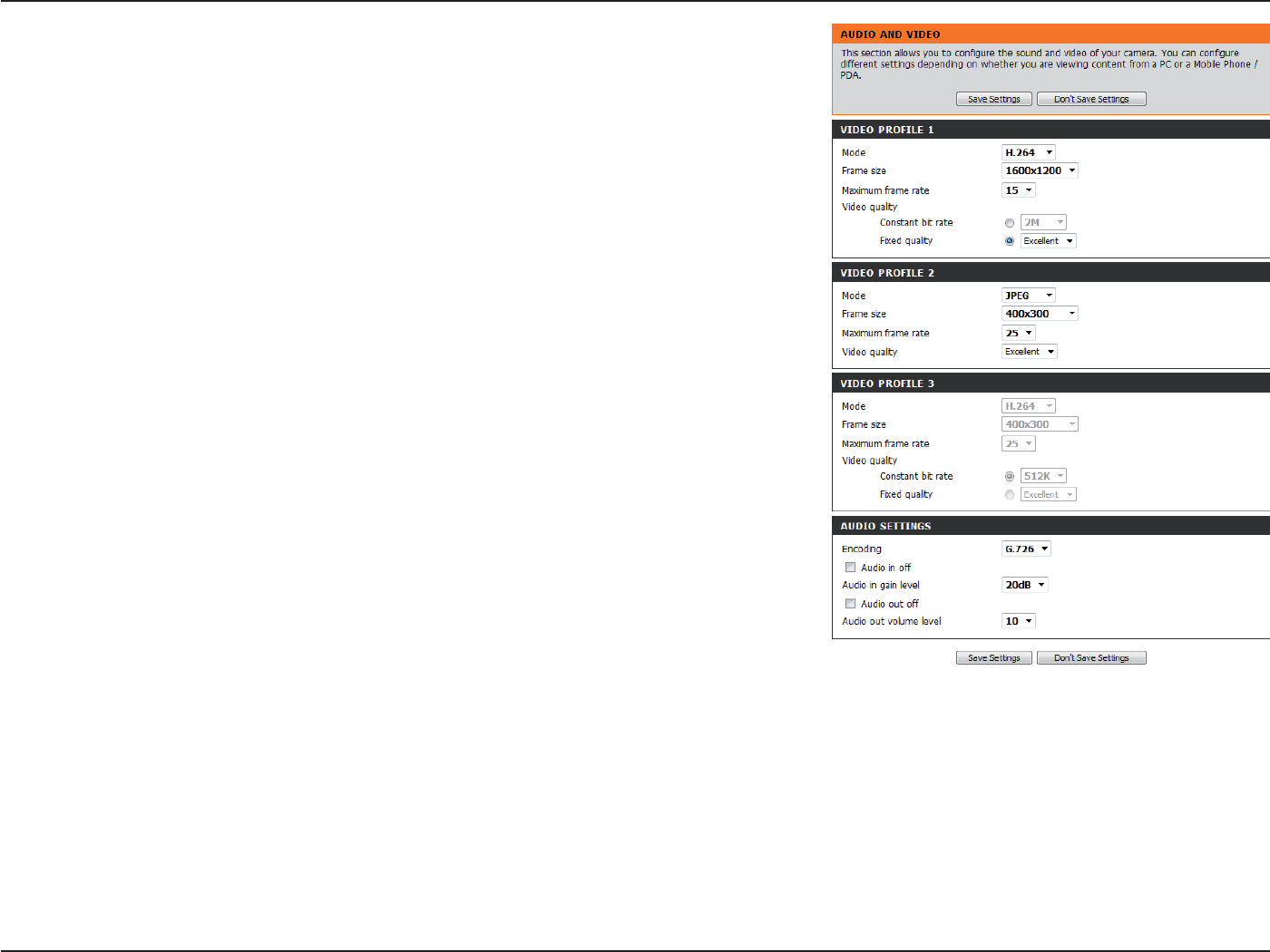
52D-Link DCS-6010L User Manual
Section 4: Conguration
Audio in o:
Audio in gain level:
Audio out o:
Audio out volume level:
Selecting this checkbox will mute incoming audio.
This setting controls the amount of gain applied to
incoming audio to increase its volume.
Selecting this checkbox will mute outgoing audio.
This setting controls the amount of gain applied to
outgoing audio to increase its volume.
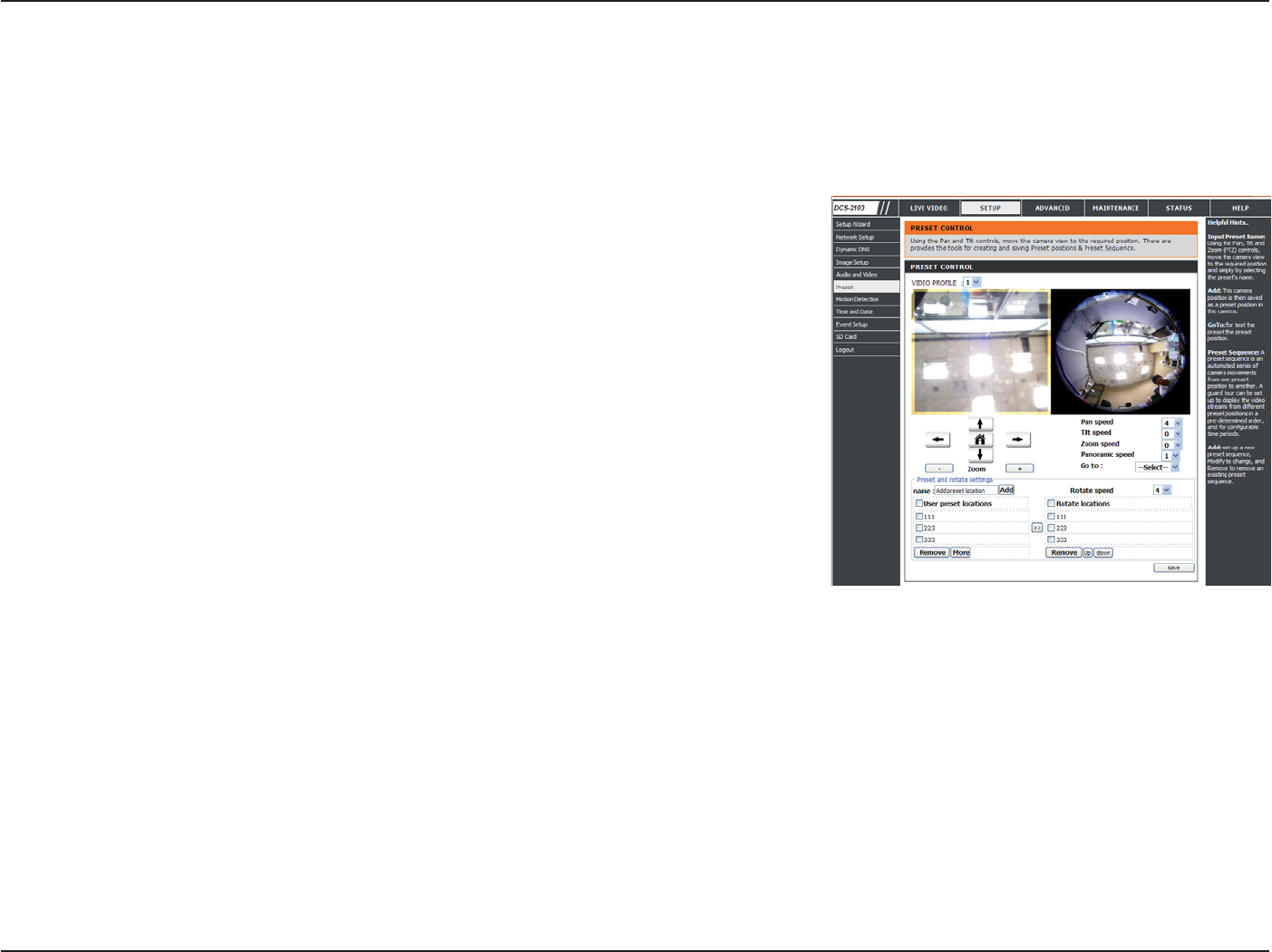
53D-Link DCS-6010L User Manual
Section 4: Conguration
Preset
This screen allows you to set preset points for the ePTZ function of the camera, which allows you to look around the camera's viewable area by
using a zoomed view. Presets allow you to quickly go to and view a specic part of the area your camera is covering, and you can create preset
sequences, which will automatically change the camera's view between the dierent presets according to a dened order and timing you can set.
Video Prole:
Arrow Buttons and Home Button:
Input Preset Name:
Preset List:
Preset Sequence:
This selects which video prole to use.
Use these buttons to move to a specic part of the
viewing area, which you can then set as a preset. Click
the Home button to return to the center of the viewing
area.
Enter the name of the preset you want to create, then
click the Add button to make a new preset. If an existing
preset has been selected from the Preset List, you can
change its name by typing in a new name, then clicking
the Rename button.
Click this drop-down box to see a list of all the presets
that have been created. You can select one, then click
the GoTo button to change the displayed camera view
to the preset. Clicking the Remove button will delete
the currently selected preset.
This section allows you to create a preset sequence,
which automatically moves the camera's view between
a set of preset views.
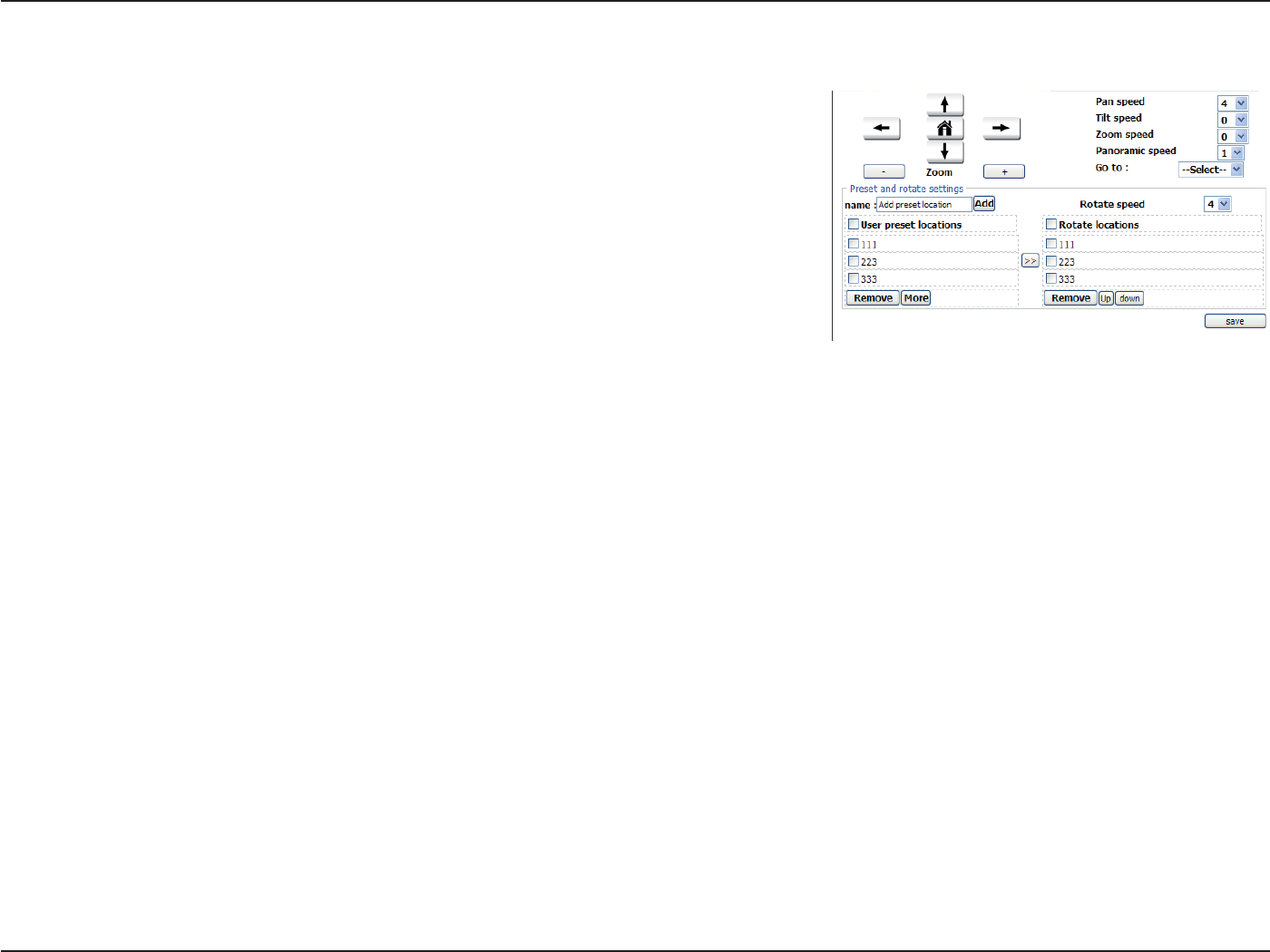
54D-Link DCS-6010L User Manual
Section 4: Conguration
Preset List: To add a preset to the sequence, select it from the drop-
down box at the bottom of this window, set the Dwell
time to determine how long the camera view will stay at
that preset, then click the Add button. The preset name
will appear in the list, followed by the dwell time to view
that preset for.
You can rearrange your presets in the sequence by
selecting a preset in the sequence, then clicking the
arrow buttons to move it higher or lower in the current
sequence.
Clicking the trash can button will remove the currently
selected preset from the sequence.
If you want to change the dwell time for a preset, select
it from the list, enter a new dwell time, then click the
Update button.
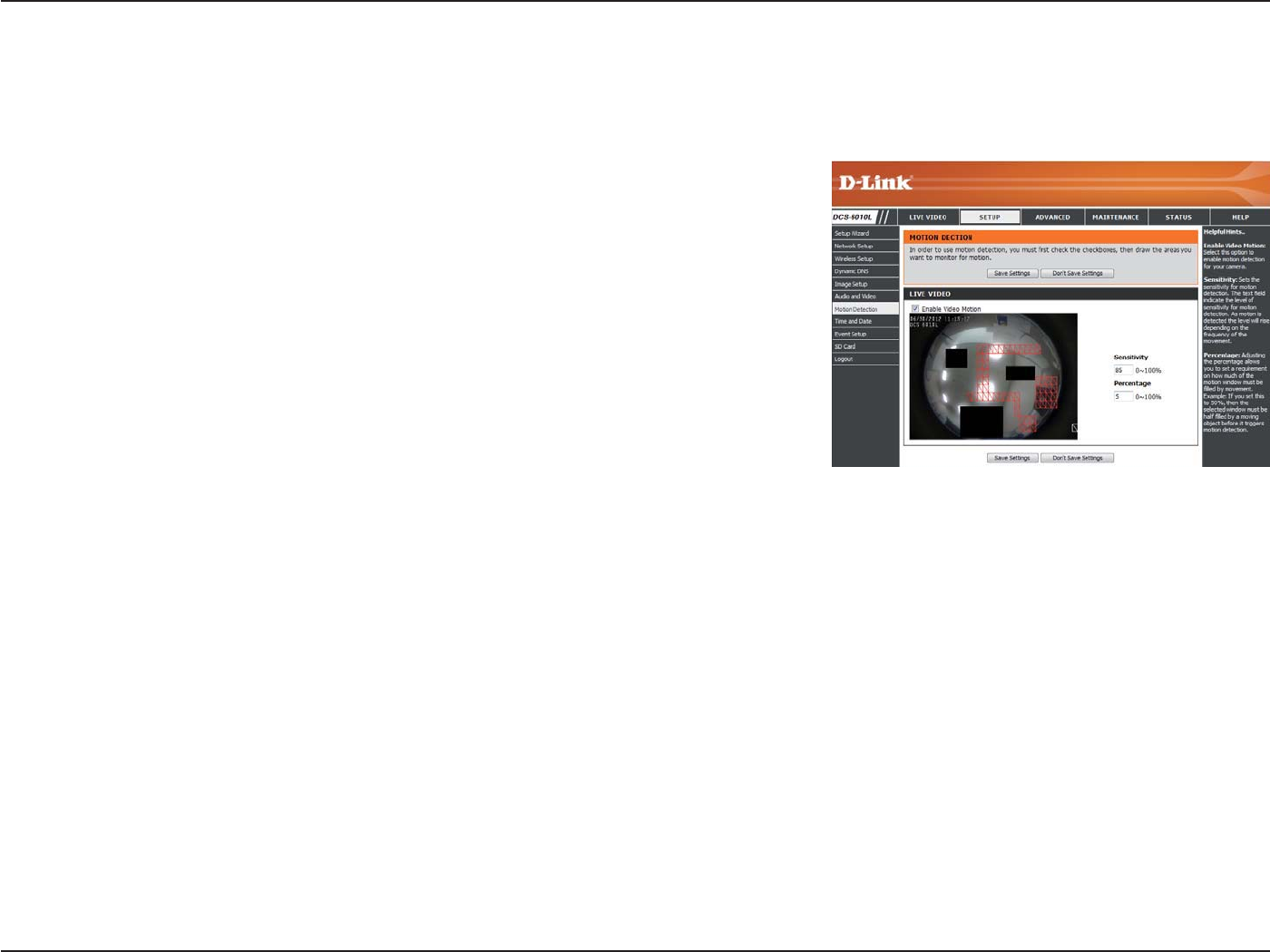
55D-Link DCS-6010L User Manual
Section 4: Conguration
Motion Detection
Enabling Video Motion will allow your camera to use the motion detection feature. You may draw a nite motion area that will be used for
monitoring. After making any changes, click the Save Settings button to save your changes.
Enable Video Motion:
Sensitivity:
Percentage:
Draw Motion Area:
Erase Motion Area:
Select this box to enable the motion detection feature
of your camera.
Species the measurable dierence between two
sequential images that would indicate motion. Please
enter a value between 0 and 100.
Species the amount of motion in the window being
monitored that is required to initiate an alert. If this is set
to 100%, motion is detected within the whole window
will trigger a snapshot.
Draw the motion detection area by dragging your mouse
in the window (indicated by the red square).
To erase a motion detection area, simply click on the red
square that you wish to remove.
Right clicking on the camera image brings up the
following menu options:
Select All: Draws a motion detection area over the
entire screen.
Clear All: Clears any motion detection areas that have
been drawn.
Restore: Restores the previously specied motion
detection areas.
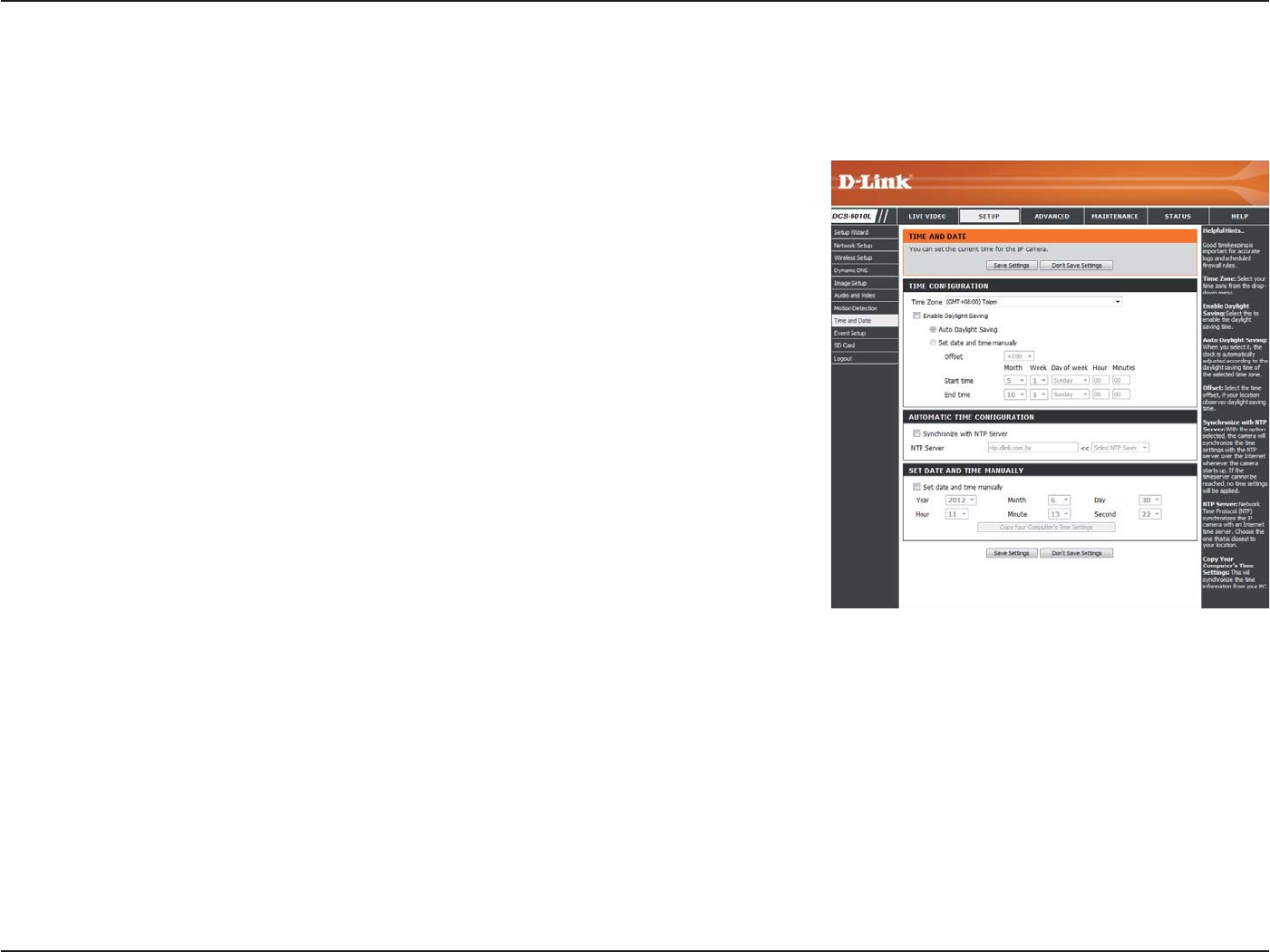
56D-Link DCS-6010L User Manual
Section 4: Conguration
Time and Date
This section allows you to automatically or manually congure, update, and maintain the internal system clock for your camera. After making any
changes, click the Save Settings button to save your changes.
Time Zone:
Enable Daylight Saving:
Auto Daylight Saving:
Set Date and Time Manually:
Oset:
Synchronize with NTP Server:
NTP Server:
Set the Date and Time Manually:
Copy Your Computer's Time
Settings:
Select your time zone from the drop-down menu.
Select this to enable Daylight Saving Time.
Select this option to allow your camera to congure the
Daylight Saving settings automatically.
Selecting this option allows you to congure the Daylight
Saving date and time manually.
Sets the amount of time to be added or removed when
Daylight Saving is enabled.
Enable this feature to obtain time automatically from an
NTP server.
Network Time Protocol (NTP) synchronizes the
DCS-6010L with an Internet time server. Choose the one
that is closest to your location.
This option allows you to set the time and date manually.
This will synchronize the time information from your PC.
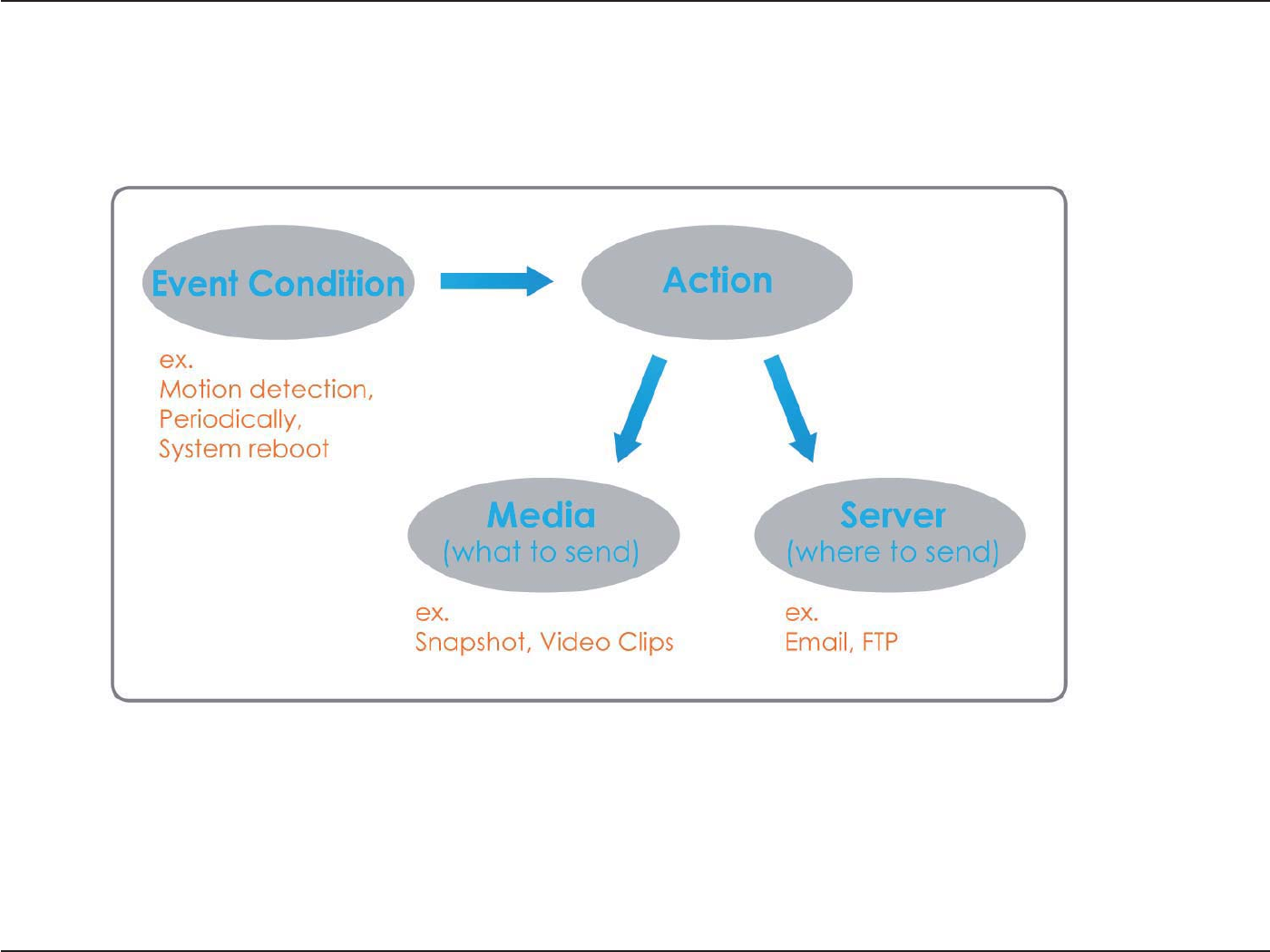
57D-Link DCS-6010L User Manual
Section 4: Conguration
Event Setup
In a typical application, when motion is detected, the DCS-6010L sends images to a FTP server or via e-mail as notications. As shown in the
illustration below, an event can be triggered by many sources, such as motion detection. When an event is triggered, a specied action will be
performed. You can congure the Network Camera to send snapshots or videos to your e-mail address or FTP site.
To start plotting an event, it is suggested to congure server and media columns rst so that the Network Camera will know what action shall be
performed when a trigger is activated.
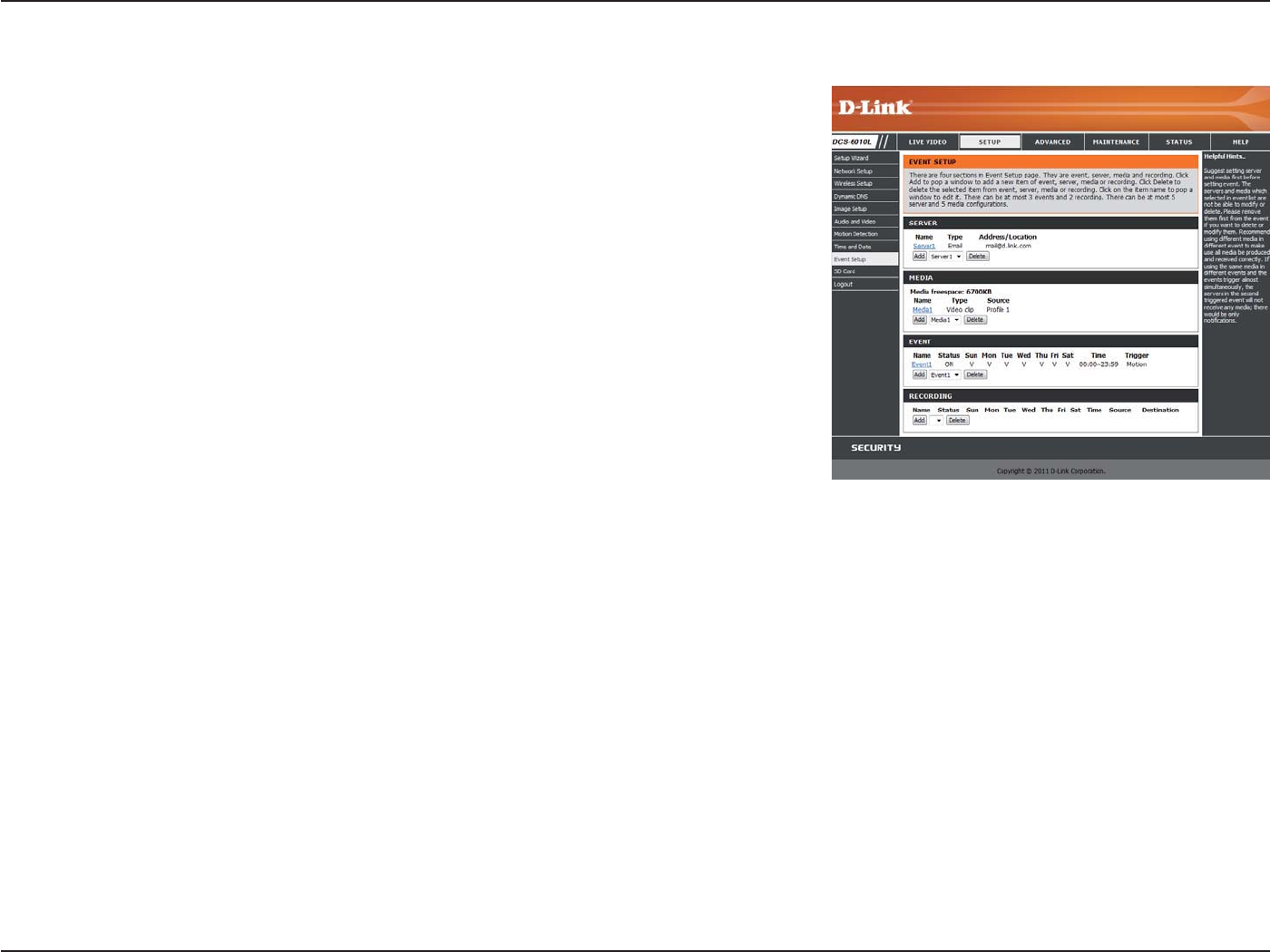
58D-Link DCS-6010L User Manual
Section 4: Conguration
The Event Setup page includes 4 dierent sections.
• Event
• Server
• Media
• Recording
1. To add a new item - "event, server or media," click Add. A screen will appear and allow you
to update the elds accordingly.
2. To delete the selected item from the pull-down menu of event, server or media, click Delete.
3. Click on the item name to pop up a window for modifying.
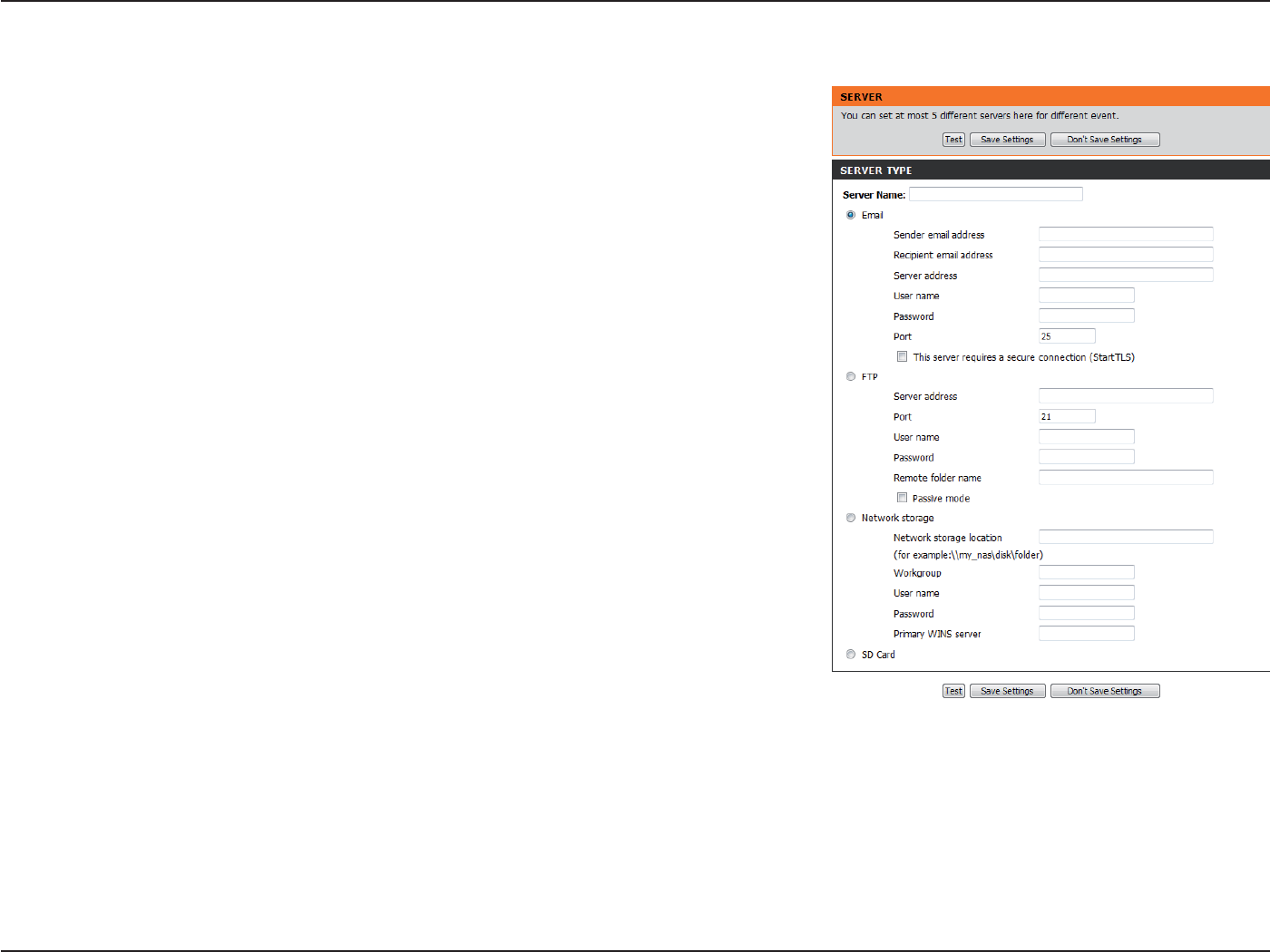
59D-Link DCS-6010L User Manual
Section 4: Conguration
Add Server
Server Name:
E-mail:
FTP:
Network Storage:
SD Card:
Enter the unique name of your server.
Enter the conguration for the target e-mail server
account.
Enter the conguration for the target FTP server account.
Specify a network storage device. Only one network
storage device is supported.
Use the camera's onboard SD card storage.
You can congure up to 5 servers to save snapshots and/or video to. After making any
changes, click the Save Settings button to save your changes.
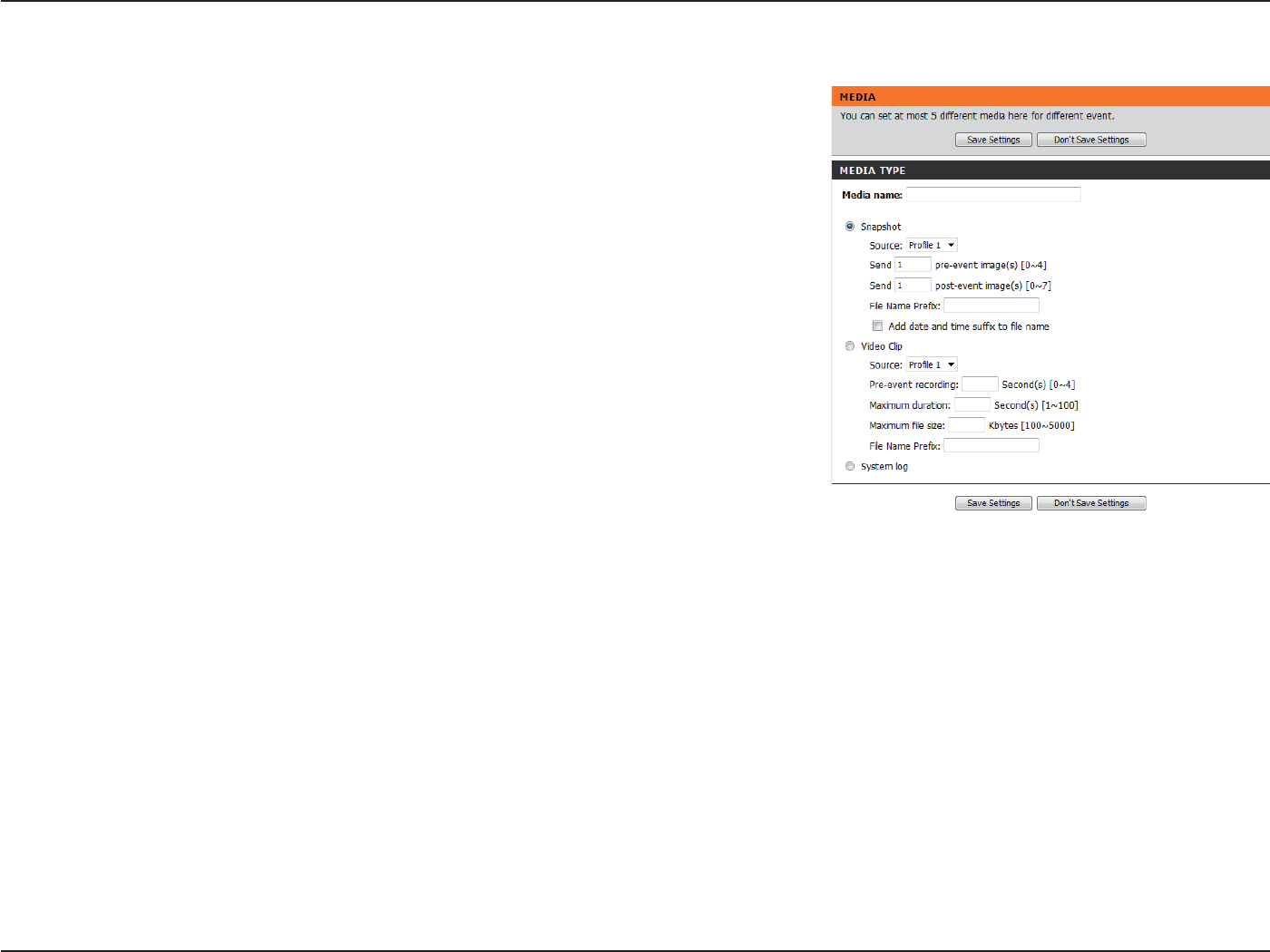
60D-Link DCS-6010L User Manual
Section 4: Conguration
Add Media
Media Name:
Snapshot:
Source:
Send pre-event image(s) [0~4]:
Send post-event image(s) [0~7]:
File name prex:
Add date and time sux to le
name:
Enter a unique name for media type you want to create.
Select this option to set the media type to snapshots.
Set the video prole to use as the media source. Refer
to Audio and Video on "Audio and Video" on page 51 for
more information on video proles.
Set the number of pre-event images to take. Pre-event
images are images taken before the main event snapshot
is taken.
Set the number of post-event images to take. Post-event
images are images taken after the main event snapshot
is taken. You can set up to 7 post-event images to be
taken.
The prex name will be added on the le name.
Check it to add timing information as le name sux.
There are three types of media, Snapshot, Video Clip, and System Log. After making any
changes, click the Save Settings button to save your changes.
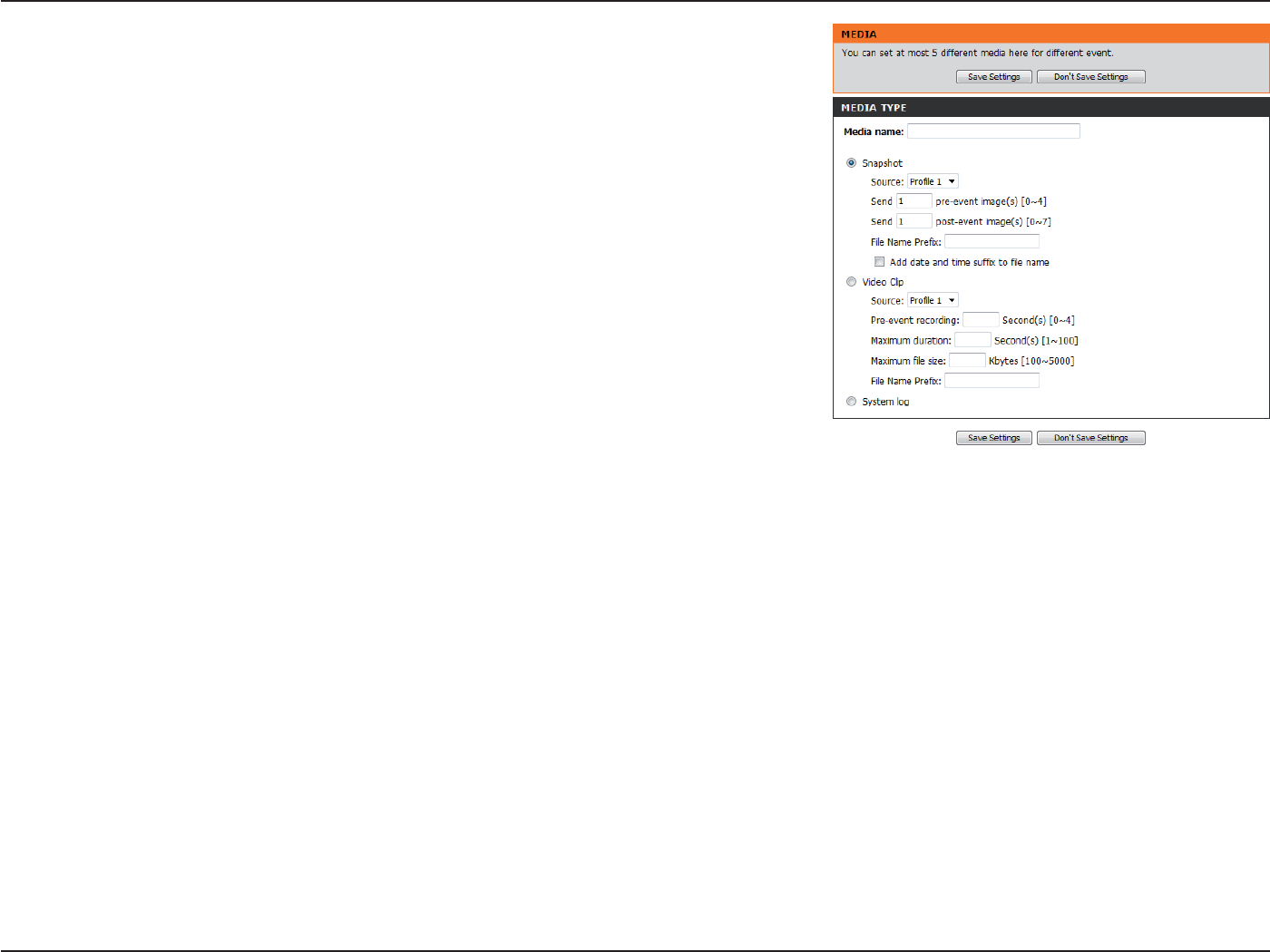
61D-Link DCS-6010L User Manual
Section 4: Conguration
Video clip:
Source:
Pre-event recording:
Maximum duration:
Maximum le size:
File name prex:
System log:
Select this option to set the media type to video clips.
Set the video prole to use as the media source. Refer to
"Audio and Video" on page 46 for more information on
video proles.
This sets how many seconds to record before the main
event video clip starts. You can record up to 4 seconds of
pre-event video.
Set the maximum length of video to record for your
video clips.
Set the maximum le size to record for your video clips.
This is the prex that will be added to the lename of
saved video clips.
Select this option to set the media type to system logs.
This will save the event to the camera system log, but
will not record any snapshots or video.
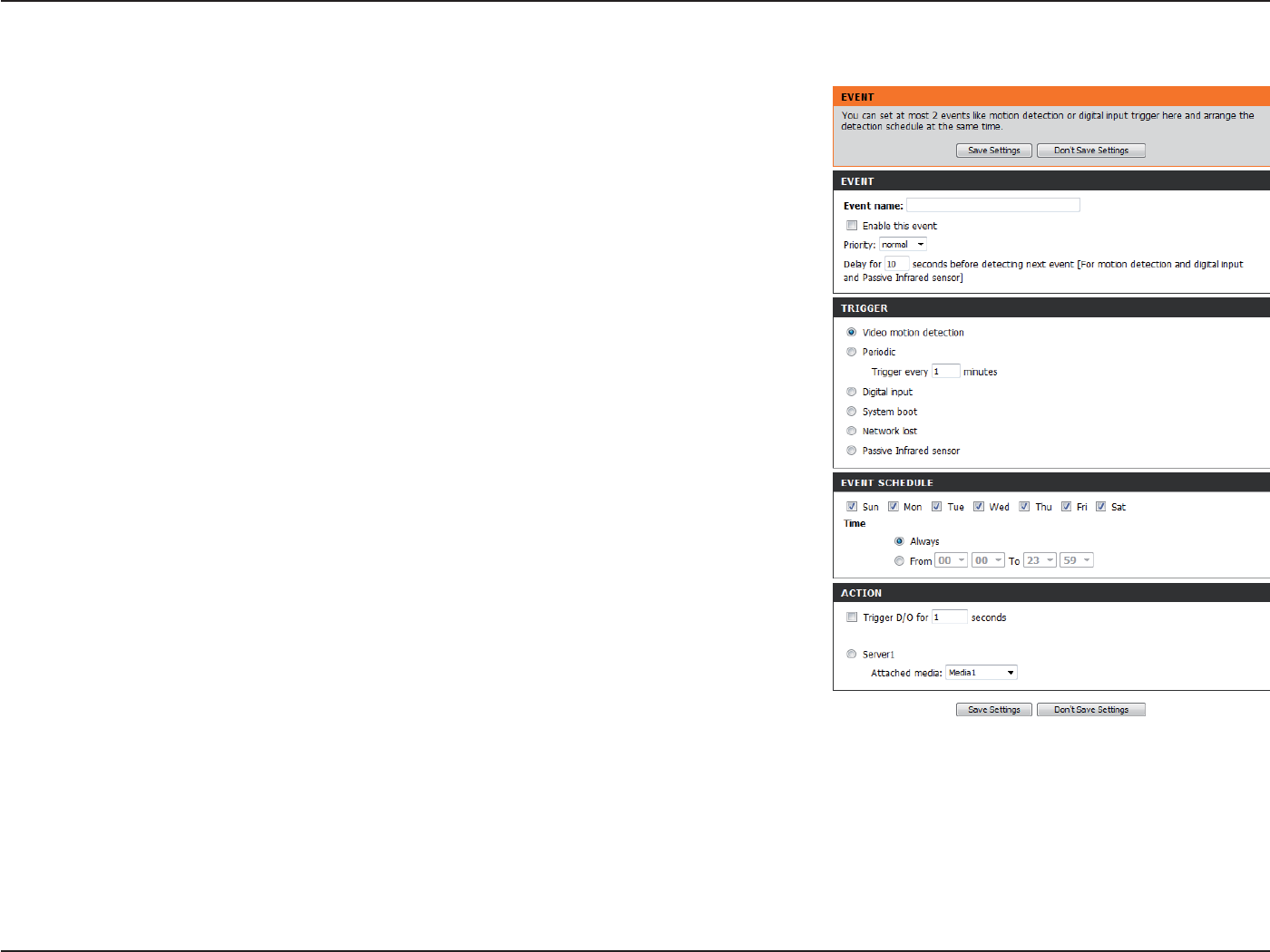
62D-Link DCS-6010L User Manual
Section 4: Conguration
Add Event
Create and schedule up to 2 events with their own settings here. After making any changes,
click the Save Settings button to save your changes.
Event name:
Enable this event:
Priority:
Delay:
Trigger:
Video Motion Detection:
Periodic:
System Boot:
Network Lost:
Passive Infrared Sensor:
Time:
Server:
Enter a name for the event.
Select this box to activate this event.
Set the priority for this event. The event with higher
priority will be executed rst.
Select the delay time before checking the next event. It is
used for motion detection events.
Specify the input type that triggers the event.
Motion is detected during live video monitoring. Select
the windows that need to be monitored.
The event is triggered in specied intervals. The trigger
interval unit is in minutes.
Triggers an event when the system boots up.
Triggers an event when the network connection is lost.
Triggers an event when the PIR sensor is activated by
moving infrared objects even in dark environment.
Select Always or enter the time interval.
Specify the location where the event information should
be saved to.
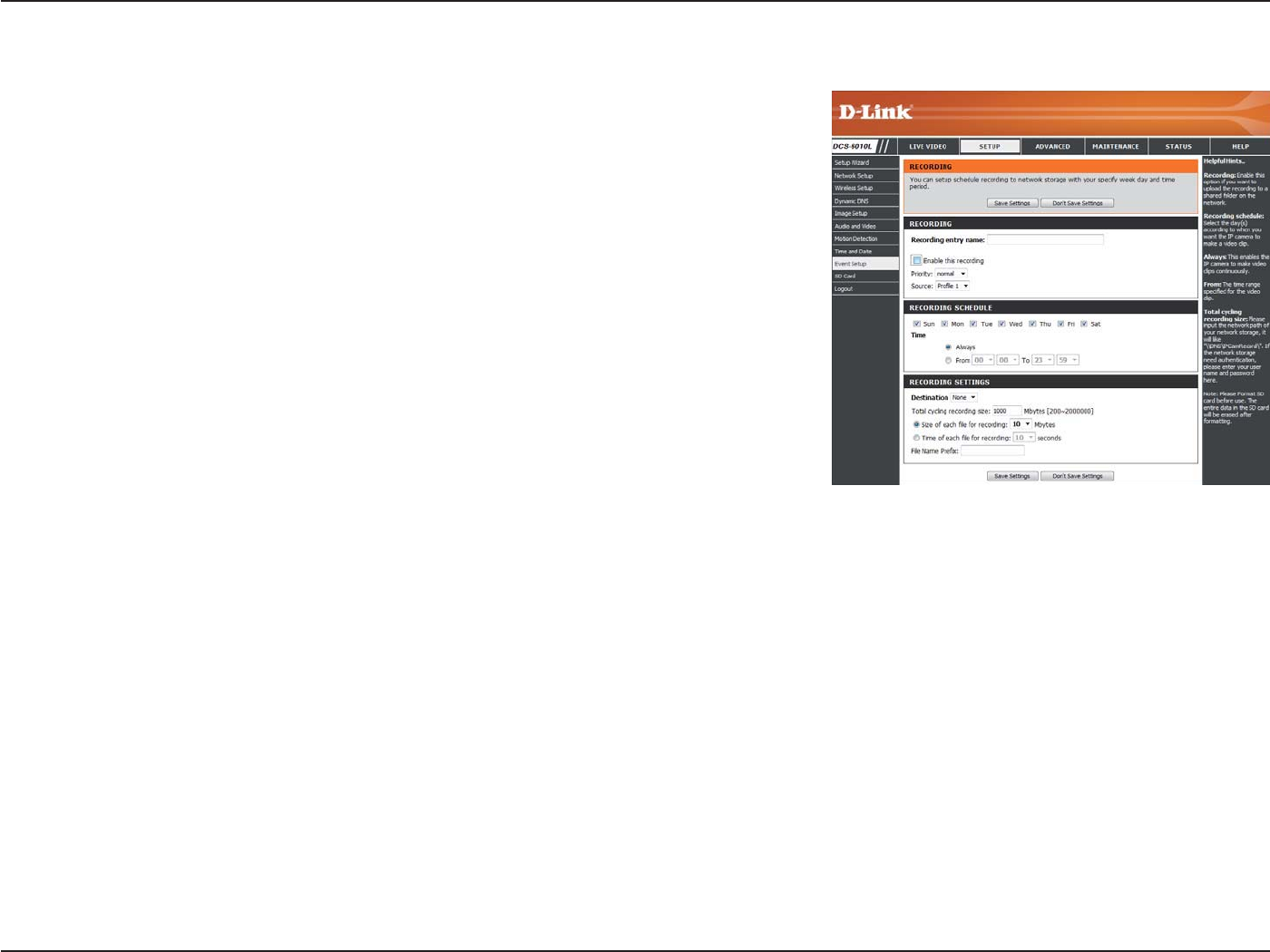
63D-Link DCS-6010L User Manual
Section 4: Conguration
Add Recording
Recording entry name:
Enable this recording:
Priority:
Source:
Recording schedule:
Recording settings:
Destination:
Total cycling recording size:
The unique name of the entry.
Select this to enable the recording function.
Set the priority for this entry. The entry with a higher
priority value will be executed rst.
The source of the stream.
Scheduling the recording entry.
Conguring the setting for the recording.
Select the folder where the recording le will be stored.
Please input a HDD volume between 1MB and 2TB for
recording space. The recording data will replace the
oldest record when the total recording size exceeds this
value. For example, if each recording le is 6MB, and the
total cyclical recording size is 600MB, then the camera
will record 100 les in the specied location (folder) and
then will delete the oldest le and create new le for
cyclical recording.
Please note that if the free HDD space is not enough, the
recording will stop. Before you set up this option please
make sure your HDD has enough space, and it is better to
not save other les in the same folder as recording les.
Here you can congure and schedule the recording settings. After making any changes,
click the Save Settings button to save your changes.
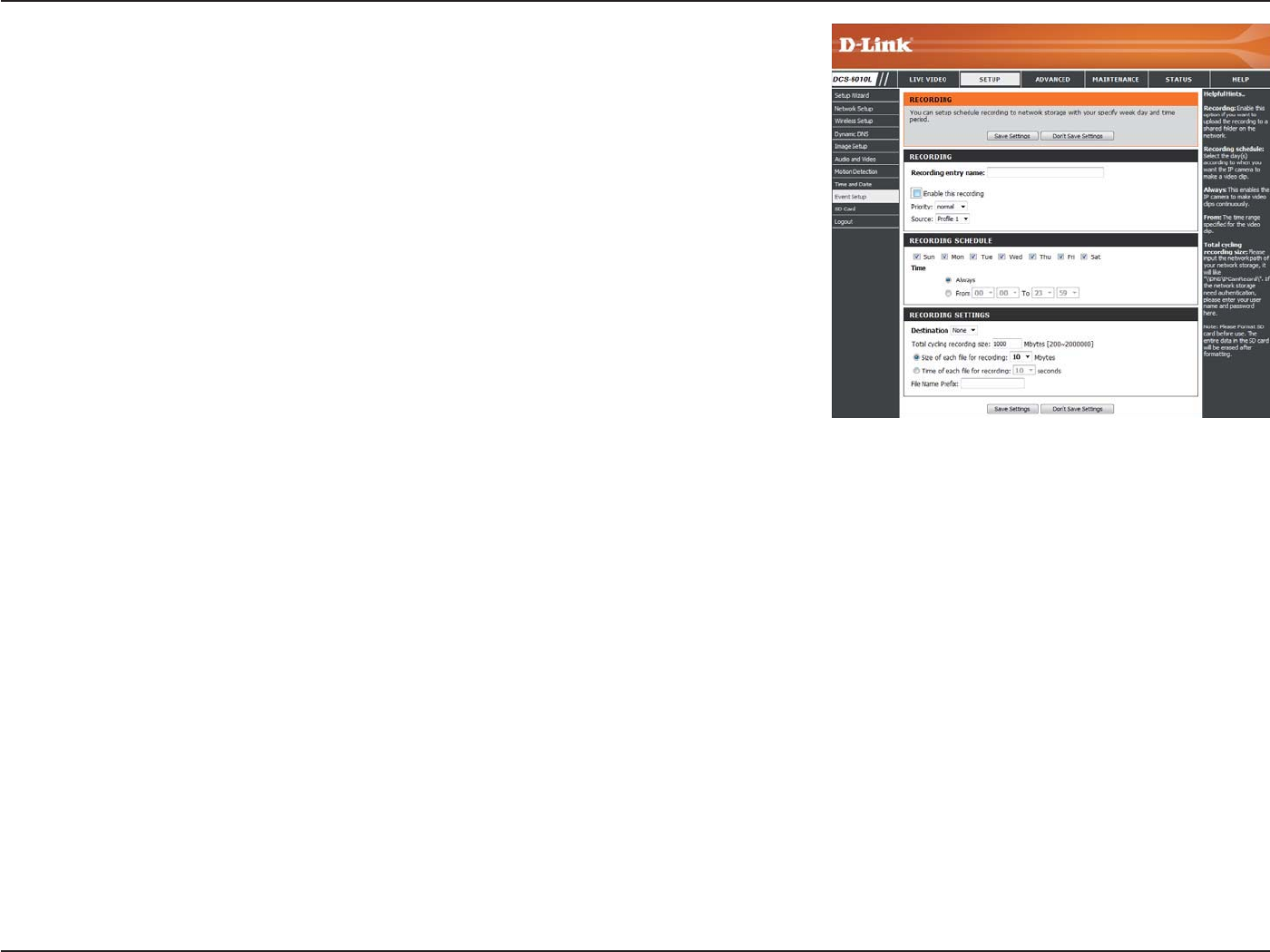
64D-Link DCS-6010L User Manual
Section 4: Conguration
Size of each le for recording:
Time of each le for recording:
File Name Prex:
If this is selected, les will be separated based on the le
size you specify.
If this is selected, les will be separated based on the
maximum length you specify.
The prex name will be added on the le name of the
recording le(s).
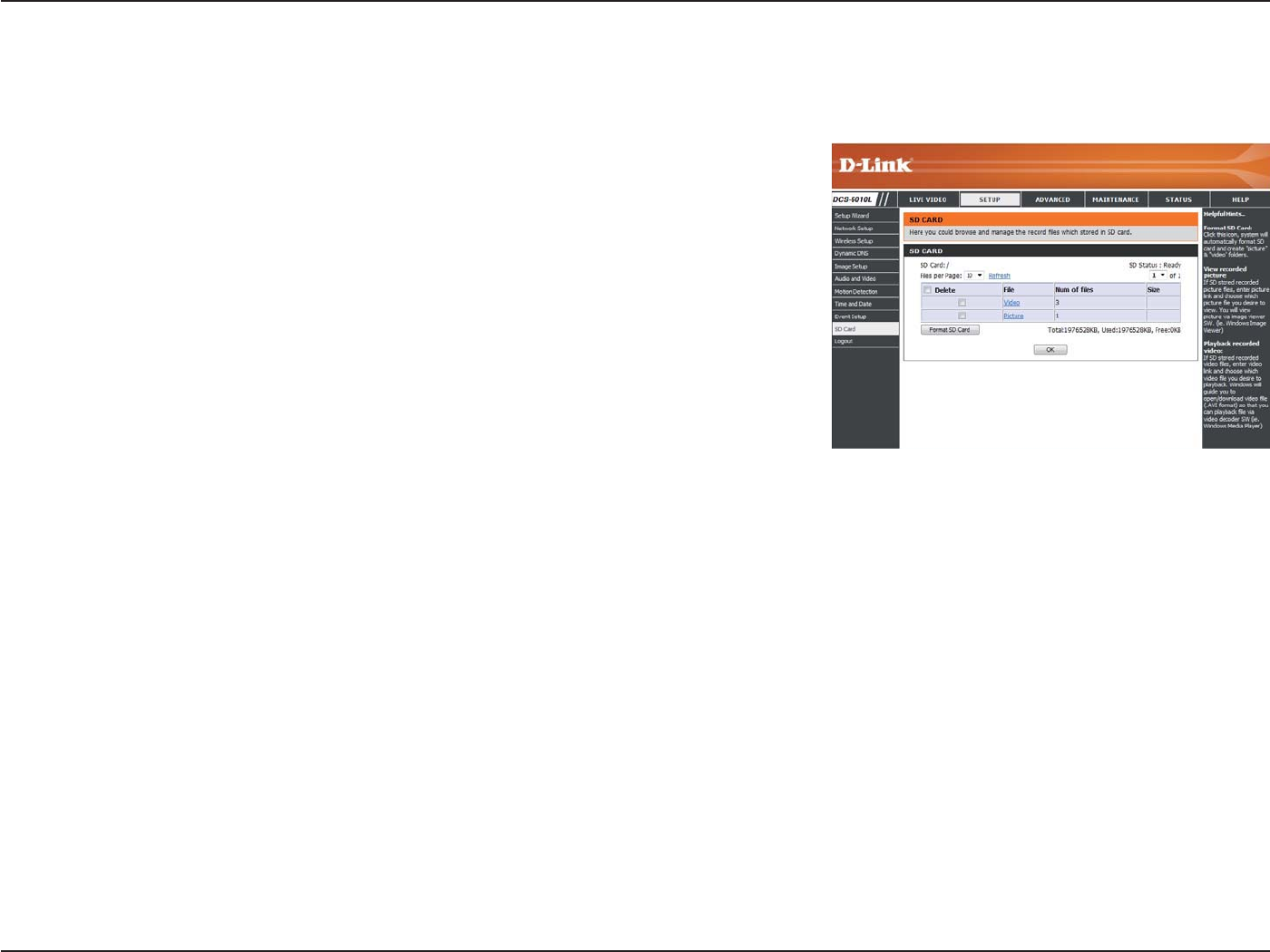
65D-Link DCS-6010L User Manual
Section 4: Conguration
SD Card
Format SD Card:
View Recorded Picture:
Playback Recorded Video:
Refresh:
Click this icon to automatically format the SD card and
create "Picture" & "Video" folders.
If the picture les are stored on the SD card, click on the
picture folder and choose the picture le you would like
to view.
If video les are stored on the SD card, click on the video
folder and choose the video le you would like to view.
Reloads the le and folder information from the SD card.
Here you may browse and manage the recorded les which are stored on the SD card.
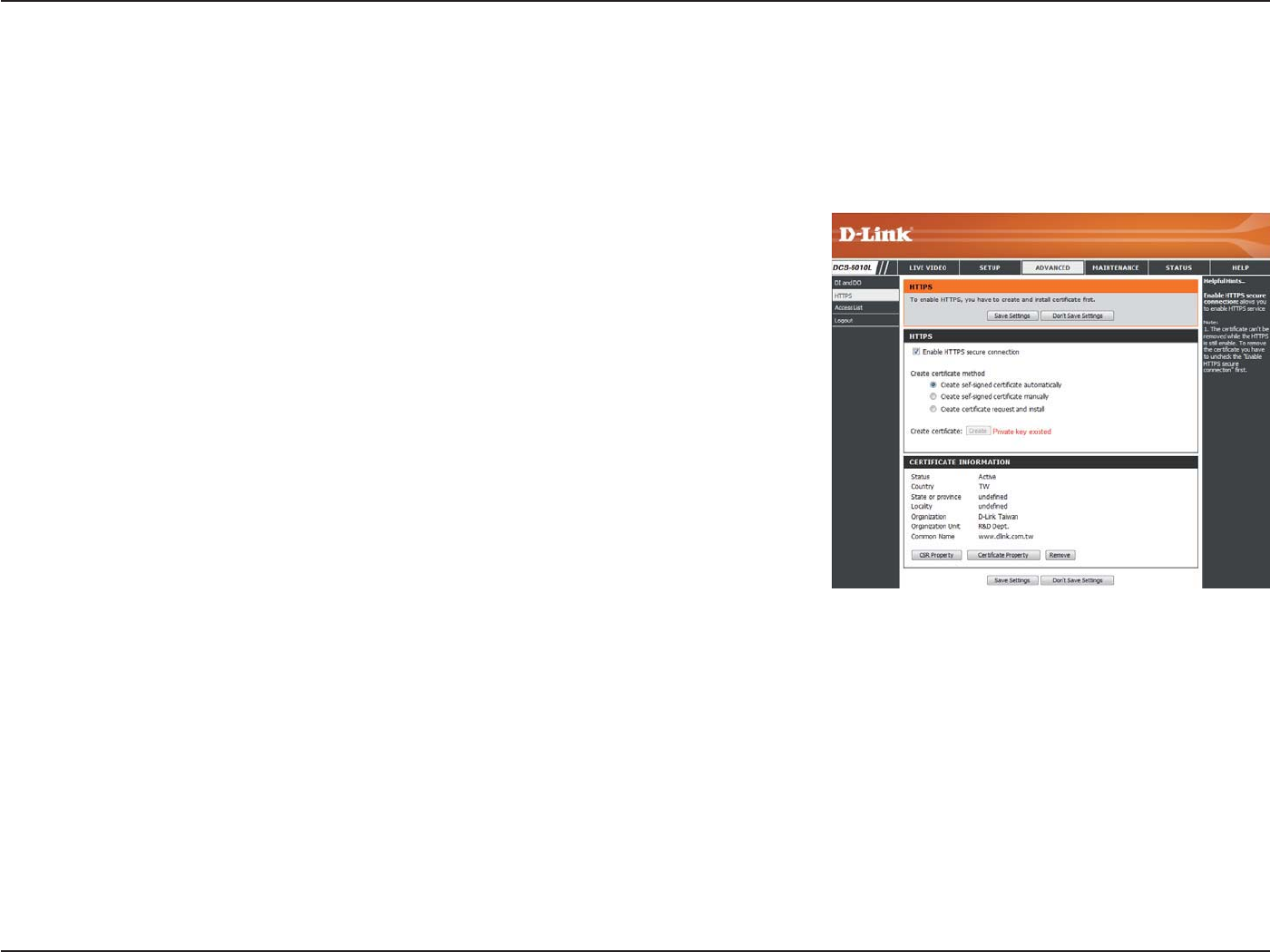
66D-Link DCS-6010L User Manual
Section 4: Conguration
Advanced
HTTPS
This page allows you to install and activate an HTTPS certicate for secure access to your camera. After making any changes, click the Save Settings
button to save your changes.
Enable HTTPS Secure Connection:
Create Certicate Method:
Status:
Note:
Enable the HTTPS service.
Choose the way the certicate should be created. Three
options are available:
Create a self-signed certicate automatically
Create a self-signed certicate manually
Create a certicate request and install
Displays the status of the certicate.
The certicate cannot be removed while the HTTPS is
still enabled. To remove the certicate, you must rst
uncheck Enable HTTPS secure connection.
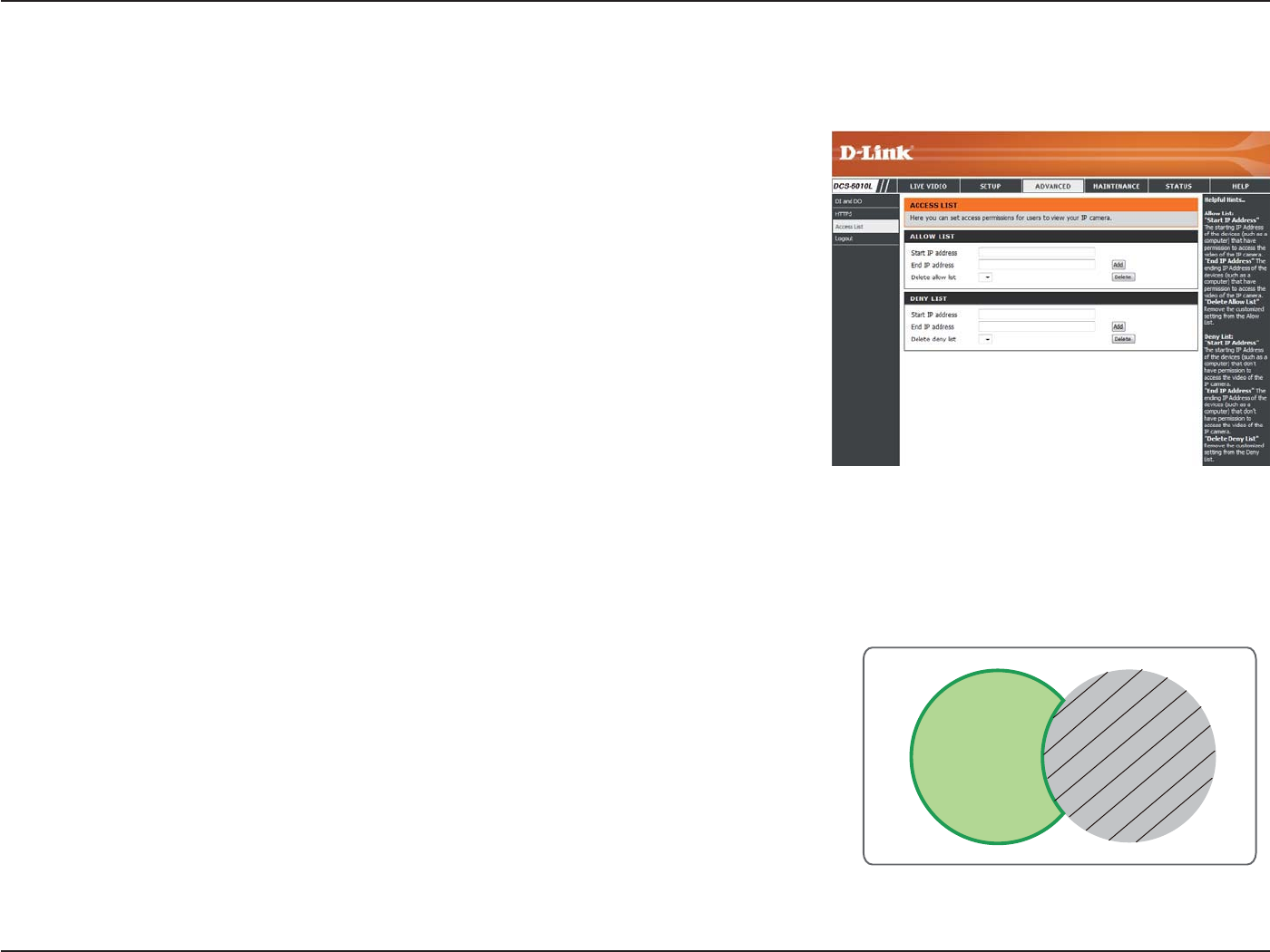
67D-Link DCS-6010L User Manual
Section 4: Conguration
Access List
Here you can set access permissions for users to view your DCS-6010L.
Allow list:
Start IP address:
End IP address:
Delete allow list:
Deny list:
Delete deny list:
The list of IP addresses that have the access right to the
camera.
The starting IP Address of the devices (such as a computer)
that have permission to access the video of the camera.
Click Add to save the changes made.
Note: A total of seven lists can be congured for both
columns.
The ending IP Address of the devices (such as a computer)
that have permission to access the video of the camera.
Remove the customized setting from the Allow List.
The list of IP addresses that have no access rights to the
camera.
Remove the customized setting from the Delete List.
For example:
When the range of the Allowed List is set from 1.1.1.0
to 192.255.255.255 and the range of the Denied List is
set from 1.1.1.0 to 170.255.255.255. Only users with IPs
located between 171.0.0.0 and 192.255.255.255 can
access the Network Camera.
$ORZHG
/LVW
'HQLHG
/LVW
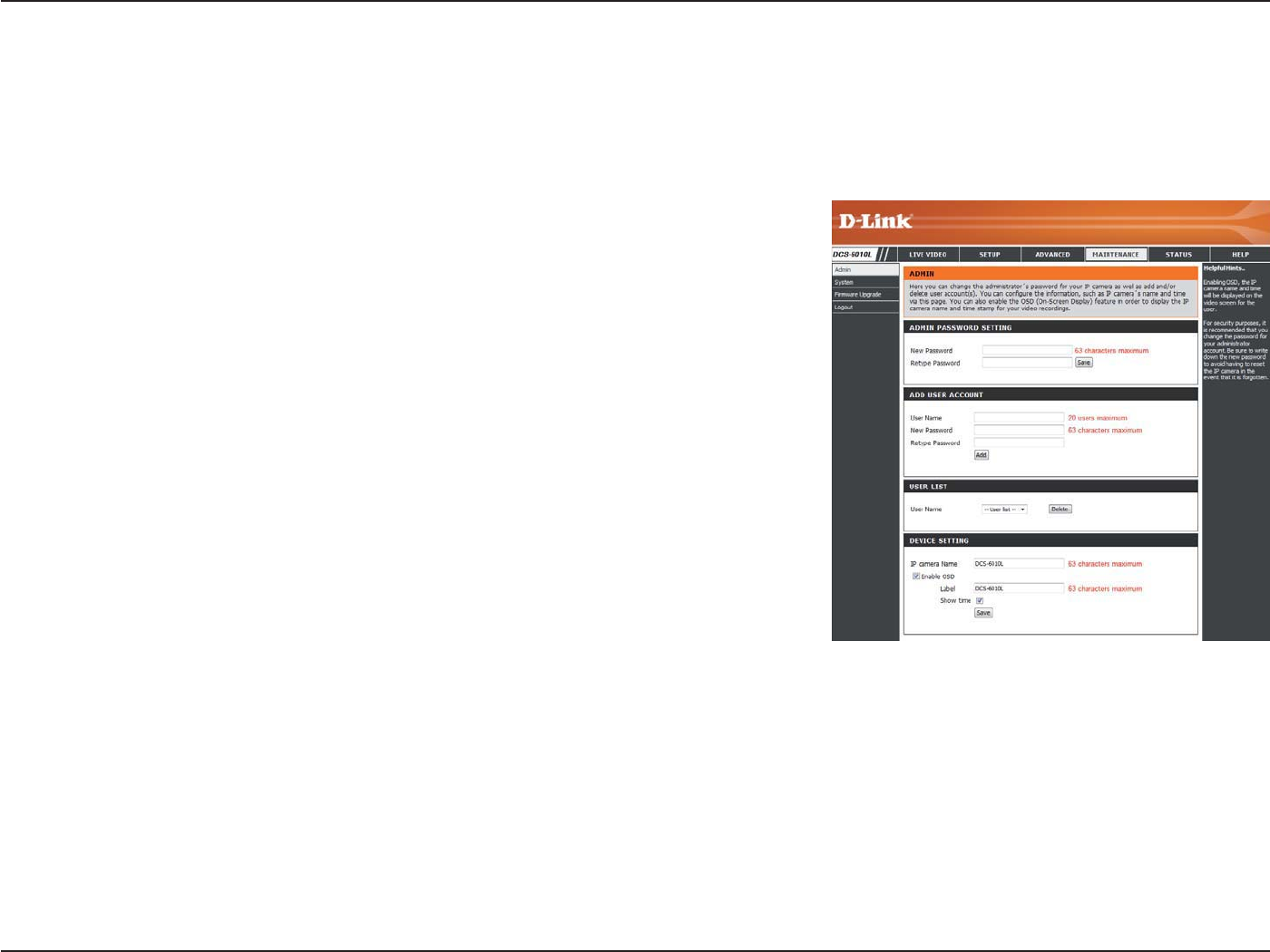
68D-Link DCS-6010L User Manual
Section 4: Conguration
Maintenance
Device Management
You may modify the name and administrator’s password of your camera, as well as add and manage the user accounts for accessing the camera.
You may also use this section to create a unique name and congure the OSD settings for your camera.
Admin Password Setting:
Add User Account:
User Name:
Password:
User List:
Camera Name:
Enable OSD:
Label:
Show Time:
Set a new password for the administrator’s account.
Add new user account.
The user name for the new account.
The password for the new account.
All the existing user accounts will be displayed here. You
may delete accounts included in the list, but you may
want to reserve at least one as a guest account.
Create a unique name for your camera that will be added
to the le name prex when creating a snapshot or a
video clip.
Select this option to enable the On-Screen Display
feature for your camera.
Enter a label for the camera, which will be shown on the
OSD when it is enabled.
Select this option to enable the time-stamp display on
the video screen.
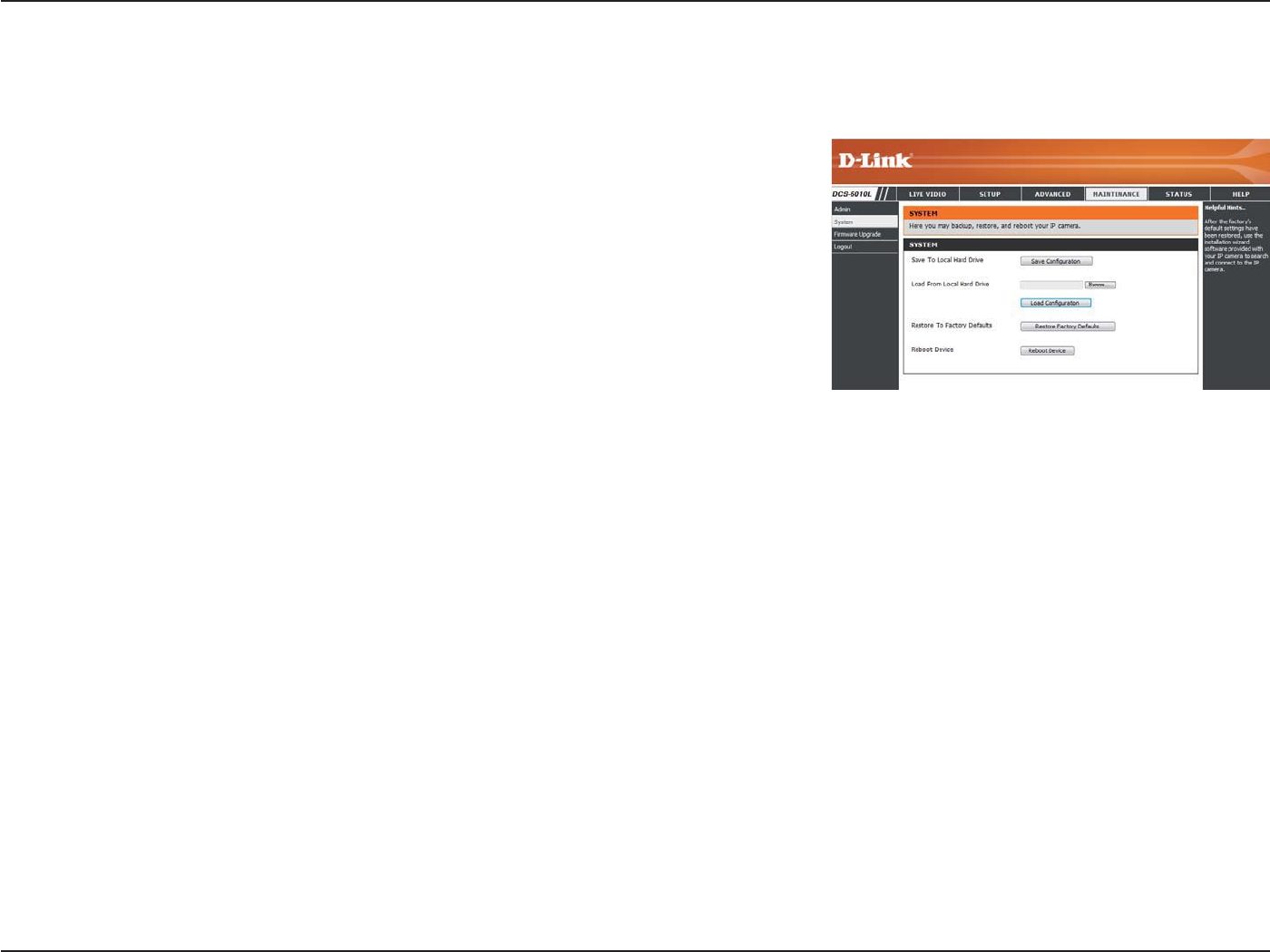
69D-Link DCS-6010L User Manual
Section 4: Conguration
Backup and Restore
In this section, you may backup, restore and reset the camera conguration, or reboot the camera.
Save To Local Hard Drive:
Local From Local Hard Drive:
Restore to Factory Default:
Reboot Device:
You may save your current camera conguration as a le
on your computer.
Locate a pre-saved conguration by clicking Browse and
then restore the pre-dened settings to your camera by
clicking Load Conguration.
You may reset your camera and restore the factory
settings by clicking Restore Factory Defaults.
This will restart your camera.
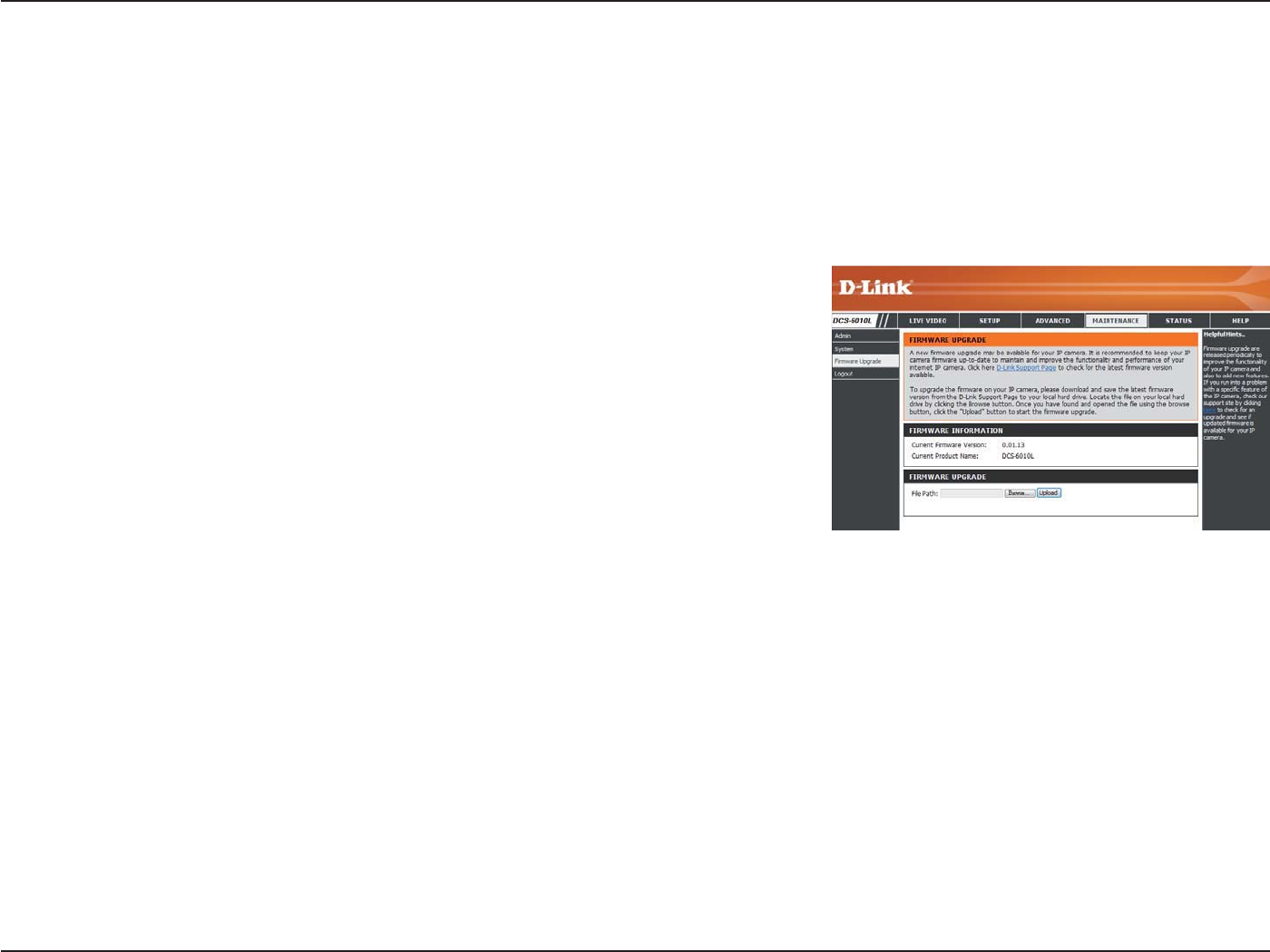
70D-Link DCS-6010L User Manual
Section 4: Conguration
Firmware Upgrade
The camera's current rmware version will be displayed on this screen. You may visit the D-Link Support Website to check for the latest available
rmware version.
To upgrade the rmware on your DCS-6010L, please download and save the latest rmware version from the D-Link Support Page to your local
hard drive. Locate the le on your local hard drive by clicking the Browse button. Select the le and click the Upload button to start upgrading the
rmware.
Current Firmware Version:
Current Product Name:
File Path:
Upload:
Displays the detected rmware version.
Displays the camera model name.
Locate the le (upgraded rmware) on your hard drive
by clicking Browse.
Uploads the new rmware to your camera.
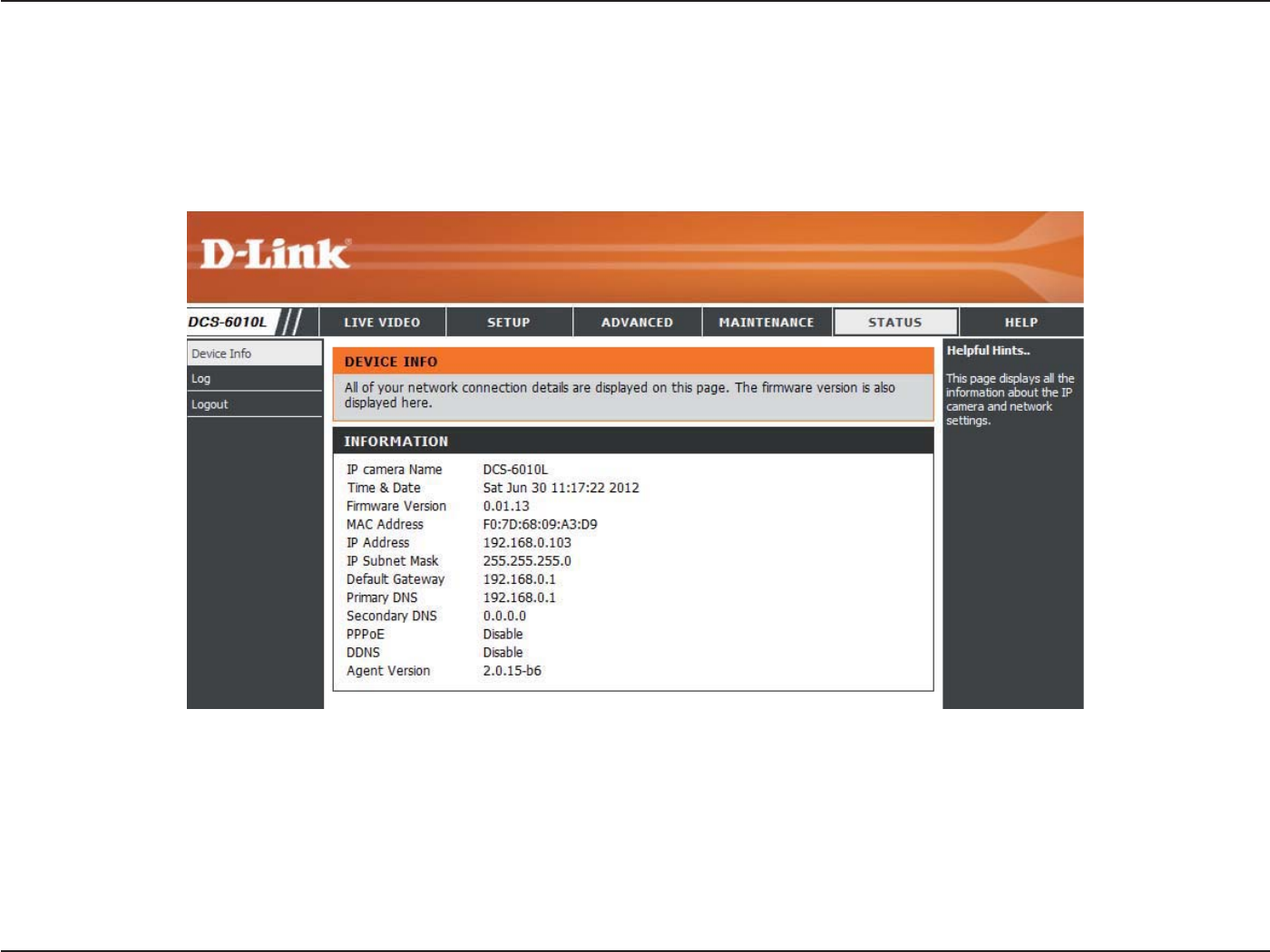
71D-Link DCS-6010L User Manual
Section 4: Conguration
Status
Device Info
This page displays detailed information about your device and network connection.
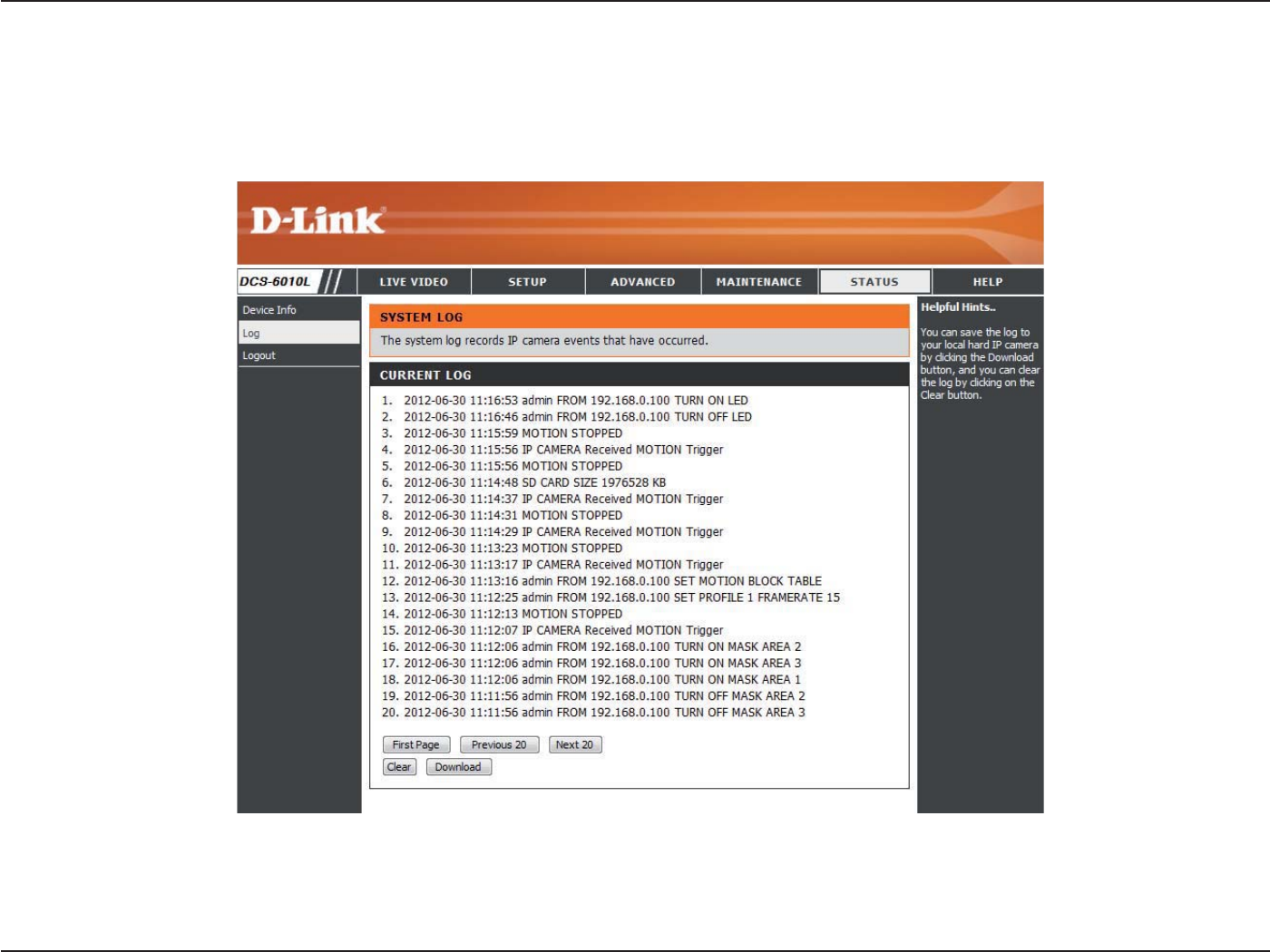
72D-Link DCS-6010L User Manual
Section 4: Conguration
This page displays the log information of your camera. You may download the information by clicking Download. You may also click Clear to delete
the saved log information.
Logs
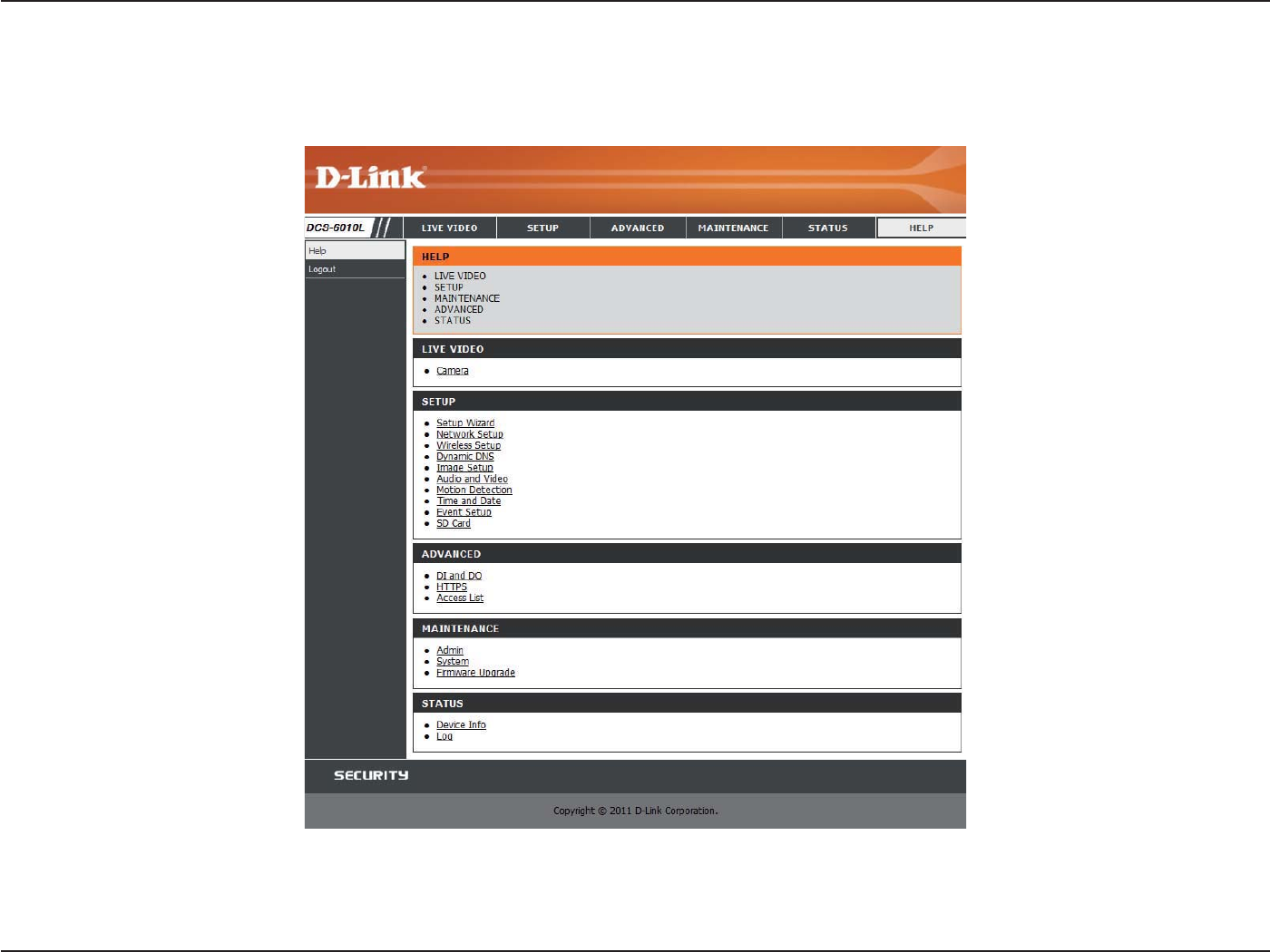
73D-Link DCS-6010L User Manual
Section 4: Conguration
This page provides helpful information regarding camera operation.
Help

74D-Link DCS-6010L User Manual
Appendix A: Technical Specications
Technical Specications
Camera Camera Hardware
Prole
1/3.2” 2 megapixel progressive CMOS sensor
Minimum illumination: 2.0 lux
Built-in microphone and speaker
10x digital zoom
Focal length: 1.25 mm
Aperture: F2.0
Angle of view:
(H) 180°
(V) 180°
(D) 180°
Image Features
Congurable image size, quality, frame rate, and bit rate
Fisheye distortion correction
Time stamp and text overlays
Congurable privacy mask zones
Congurable shutter speed, brightness, saturation, contrast,
and sharpness
Congurable motion detection windows
Video Compression
Simultaneous H.264/MPEG-4/MJPEG format compression
H.264/MPEG-4 multicast streaming
JPEG for still images
Video Resolution 1600 x 1200, 1200 x 900, 800 x 600, 400 x 300
Audio Support G.726, G.711
External Device
Interface
10/100 BASE-TX Fast Ethernet port
IEEE 802.11n 2.4GHz single band wireless
MicroSD/SDHC card slot
Network Network Protocols IPv6
IPv4
TCP/IP
UDP
ICMP
DHCP client
NTP client (D-Link)
DNS client
DDNS client (D-Link)
SMTP client
FTP client
HTTP / HTTPS
Samba Client
PPPoE
UPnP port forwarding
RTP / RTSP/ RTCP
IP ltering
QoS
CoS
Multicast
IGMP
ONVIF compliant
Security
Administrator and user group protection
Password authentication
HTTP and RTSP digest encryption

75D-Link DCS-6010L User Manual
Appendix A: Technical Specications
System
Management
System
Requirements for
Web Interface
Browser: Internet Explorer, Firefox, Chrome, Safari
Event Management
Motion detection
Event notication and uploading of snapshots/video clips via
e-mail or FTP
Supports multiple SMTP and FTP servers
Multiple event notications
Multiple recording methods for easy backup
Remote
Management
Take snapshots/video clips and save to local hard drive or NAS
via web browser
Conguration interface accessible via web browser
Mobile Support Windows 7/Vista/XP system, Pocket PC, or mobile phone mydlink mobile app for iOS and Android mobile devices
D-ViewCam™ System
Requirements
Operating System: Microsoft Windows 7/Vista/XP
Web Browser: Internet Explorer 7 or higher
Protocol: Standard TCP/IP
D-ViewCam™
Software Functions
Remote management/control of up to 32 cameras
Viewing of up to 32 cameras on one screen
Supports all management functions provided in web interface
Scheduled motion triggered, or manual recording options
General Weight 267 g +-5%
External Power
Adaptor Input: 100 to 240 V AC, 50/60 Hz Output: 5 V DC, 1.2 A
Power Consumption 3.9 watts +-5%
Temperature Operating: 0 to 40 °C (32 to 104 °F) Storage: -20 to 70 °C (-4 to 158 °F)
Humidity Operating: 20% to 80% non-condensing Storage: 5% to 95% non-condensing
Certications CE
CE LVD
FCC
C-Tick
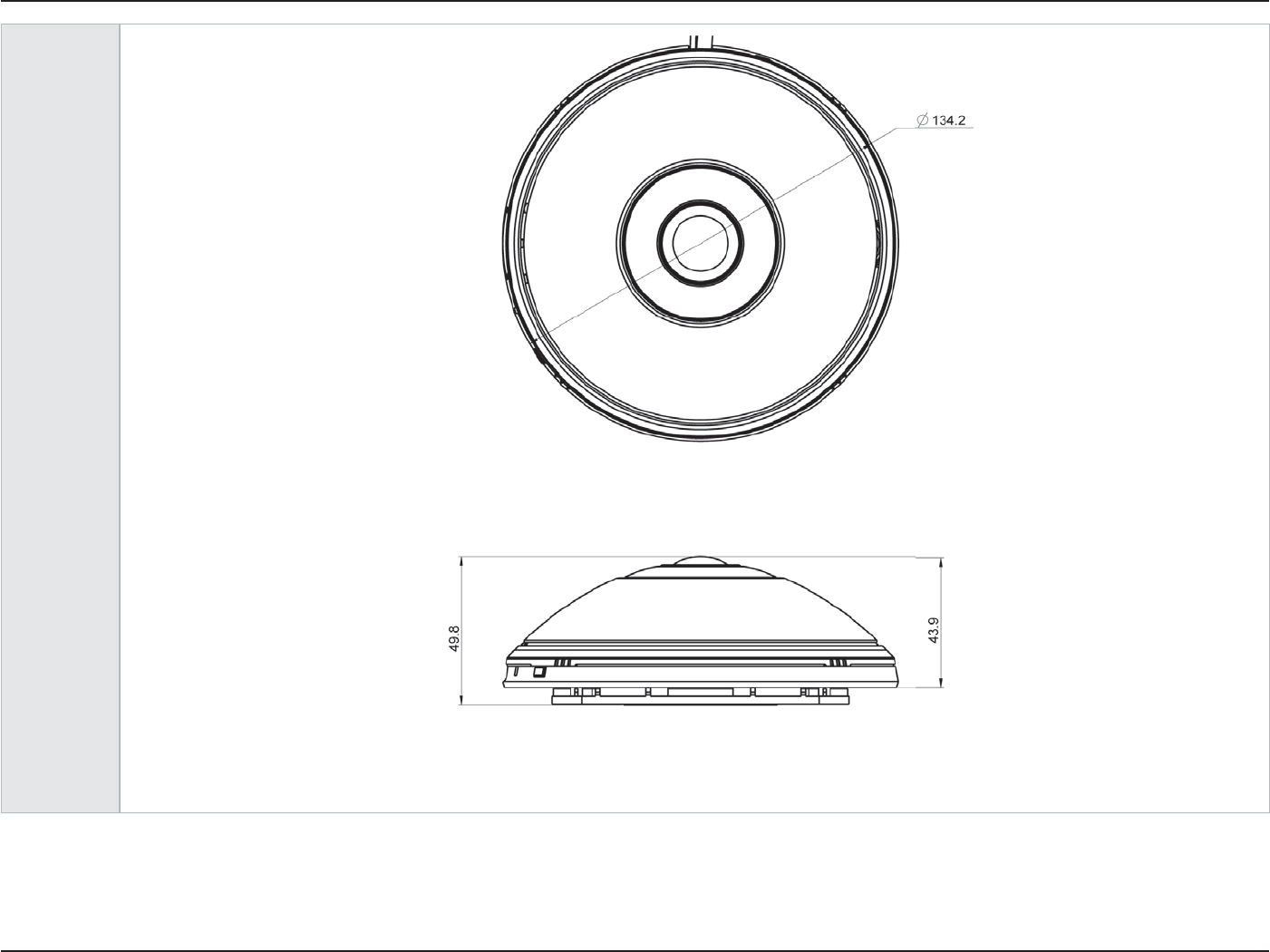
76D-Link DCS-6010L User Manual
Appendix A: Technical Specications
Dimensions
•

77D-Link DCS-6010L User Manual
Appendix B: Safety Statements
CE Mark Warning:
This is a Class B product. In a domestic environment, this product may cause radio interference, in which case the user may be required to take
adequate measures.
FCC Statement:
This equipment has been tested and found to comply with the limits for a Class B digital device, pursuant to part 15 of the FCC Rules. These limits are
designed to provide reasonable protection against harmful interference in a residential installation. This equipment generates, uses, and can radiate
radio frequency energy and, if not installed and used in accordance with the instructions, may cause harmful interference to radio communication.
However, there is no guarantee that interference will not occur in a particular installation. If this equipment does cause harmful interference to radio
or television reception, which can be determined by turning the equipment o and on, the user is encouraged to try to correct the interference by
one or more of the following measures:
• Reorient or relocate the receiving antenna.
• Increase the separation between the equipment and receiver.
• Connect the equipment into an outlet on a circuit dierent from that to which the receiver is connected.
• Consult the dealer or an experienced radio/TV technician for help.
FCC Caution:
Any changes or modications not expressly approved by the party responsible for compliance could void the user’s authority to operate this
equipment.
This device complies with Part 15 of the FCC Rules. Operation is subject to the following two conditions:
(1) This device may not cause harmful interference, and (2) this device must accept any interference received, including interference that may cause
undesired operation.
Safety Statements

78D-Link DCS-6010L User Manual
Appendix B: Safety Statements
IMPORTANT NOTICE:
FCC Radiation Exposure Statement:
This equipment complies with FCC radiation exposure limits set forth for an uncontrolled environment. This equipment should be installed and
operated with minimum distance 20cm between the radiator & your body. This transmitter must not be co-located or operating in conjunction
with any other antenna or transmitter.
The availability of some specic channels and/or operational frequency bands are country dependent and are rmware programmed at the factory
to match the intended destination. The rmware setting is not accessible by the end user.
For detailed warranty information applicable to products purchased outside the United States, please contact the corresponding local D-Link
oce.
Industry Canada Notice:
This device complies with RSS-210 of the Industry Canada Rules. Operation is subject to the following two conditions:
(1) This device may not cause harmful interference, and (2) this device must accept any interference received, including interference that may cause
undesired operation.
IMPORTANT NOTE:
Radiation Exposure Statement:
This equipment complies with IC radiation exposure limits set forth for an uncontrolled environment. This equipment should be installed and
operated with minimum distance 20cm between the radiator & your body.
FCC Notices
This device complies with Part 15 of the FCC Rules. Operation is subject to the following
two conditions: (1) this device may not cause harmful interference, and (2) this device
must accept any interference received, including interference that may cause undesired
operation.
CAUTION: Change or modification not expressly approved by the party responsible
for compliance could void the user’s authority to operate this equipment.
This equipment has been tested and found to comply with the limits for a Class B
digital device, pursuant to Part 15 of the FCC Rules. These limits are designed to provide
reasonable protection against harmful interference in a residential installation. This
equipment generates, uses and can radiate radio frequency energy and, if not installed
and used in accordance with the instructions, may cause harmful interference to radio
communications. However, there is no guarantee that interference will not occur in a
particular installation. If this equipment does cause harmful interference to radio or
television reception, which can be determined by turning the equipment off and on, the
user is encouraged to try to correct the interference by one or more of the following
measures:
--Reorient or relocate the receiving antenna.
--Increase the separation between the equipment and receiver.
--Connect the equipment into an outlet on a circuit different from that to which the receiver
is connected.
--Consult the dealer or an experienced radio/TV technician for help.
CAUTION:
Any changes or modifications not expressly approved by the grantee of this device could
void the user's authority to operate the equipment.
RF exposure warning
This equipment must be installed and operated in accordance with provided instructions
and the antenna(s) used for this transmitter must be installed to provide a separation
distance of at least 20 cm from all persons and must not be co-located or operating in
conjunction with any other antenna or transmitter. End-users and installers must be
provide with antenna installation instructions and transmitter operating conditions for
satisfying RF exposure compliance."
Canada Notices
Industry Canada regulatory information
This device complies with Industry Canada licence-exempt RSS standard(s).
Operation is subject to the following two conditions: (1) this device may not cause
interference, and (2) this device must accept any interference, including interference
that may cause undesired operation of the device.
The user is cautioned that this device should be used only as specified within this
manual to meet RF exposure requirements. Use of this device in a manner
inconsistent with this manual could lead to excessive RF exposure conditions.
Le présent appareil est conforme aux CNR d'Industrie Canada
applicables aux appareils radio exempts de licence. L'exploitation est
autorisée aux deux conditions suivantes : (1) l'appareil ne doit pas
produire de brouillage, et (2) l'utilisateur de l'appareil doit accepter tout
brouillage radioélectrique subi, même si le brouillage est susceptible
d'en compromettre le fonctionnement.
RF exposure warning
This equipment must be installed and operated in accordance with
provided instructions and the antenna(s) used for this transmitter must
be installed to provide a separation distance of at least 20 cm from all
persons and must not be co-located or operating in conjunction with any
other antenna or transmitter. End-users and installers must be provide
with antenna installation instructions and transmitter operating
conditions for satisfying RF exposure compliance."
Cet équipement doit être installé et utilisé conformément aux
instructions fournies et de l'antenne (s) utilisé pour cet émetteur doit être
installé pour fournir une distance de séparation d'au moins 20 cm de
toute personne et ne doit pas être co-localisés ou fonctionnant en
conjonction avec une autre antenne ou transmetteur. Les utilisateurs
finaux et installateurs doivent être fournir des instructions d'installation
de l'antenne et des conditions de fonctionnement du transmetteur de la
conformité sur l'exposition aux RF